

You are using an out of date browser. It may not display this or other websites correctly.
You should upgrade or use an alternative browser.
You should upgrade or use an alternative browser.
dbltree
Super Moderator
Remember to use trail cams whenever you can when comparing or testing food sources, they "observe" 24-7 and reveal what and when deer are using. They leave absolutely no doubt as to what is going on in your plots.
I didn't have the time stamp turned on but these are deer using the winter rye combo almost from the day it came up...
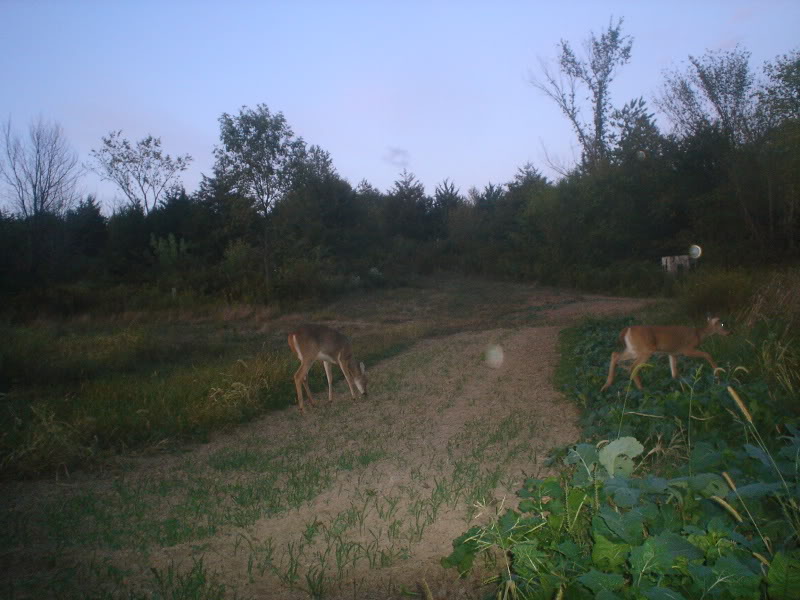
Any crop planted alone or in a different field is no comparison at all so be sure to plant comparable crops side by side

Here...deer have a choice between white clover on the left and brassicas on the right

The batteries were dead in the cam from taking so many pictures but here is a recent pic of the rye, oats, peas, radish mix that reveals heavy grazing...one observation anyone can make anywhere in any plot. Larger plots with lower deer density however will sometimes make grazing evidence far less noticeable.
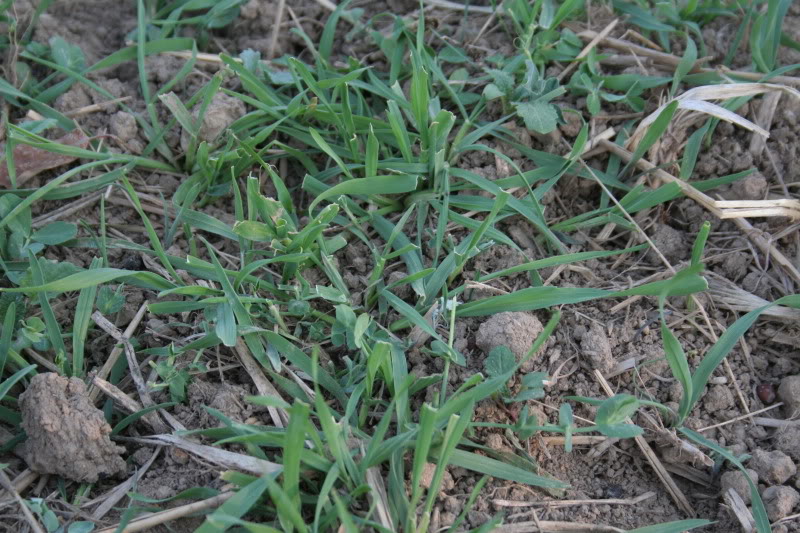
This is white clover right beside the rye and brassicas...also heavily grazed...

Over time deer will adapt to new plots and new food sources...3 years ago deer refused to touch brassicas in these strip plots but since adding Groundhog forage radish they have over time adapted to feeding on brassicas and in fact seem now intent on wiping them out!

This is the most common sight....deer feeding in all three crop types and one would most likely find this scenario if comparing 3 white clovers, brassicas or cereals in a side by side test.

Often we put too much emphasis on "deer preference" when in fact, once adapted to finding year around food sources in a safe centralized feeding area adjacent to a secure bedding area....they will usually eat nearly anything you plant and very little can lure them away. First year observations may then be different from 2nd and 3rd year comparisons depending on the situation in and around your property so keep track via trail cams and the results may prove interesting down the road....
I didn't have the time stamp turned on but these are deer using the winter rye combo almost from the day it came up...

Any crop planted alone or in a different field is no comparison at all so be sure to plant comparable crops side by side

Here...deer have a choice between white clover on the left and brassicas on the right

The batteries were dead in the cam from taking so many pictures but here is a recent pic of the rye, oats, peas, radish mix that reveals heavy grazing...one observation anyone can make anywhere in any plot. Larger plots with lower deer density however will sometimes make grazing evidence far less noticeable.

This is white clover right beside the rye and brassicas...also heavily grazed...

Over time deer will adapt to new plots and new food sources...3 years ago deer refused to touch brassicas in these strip plots but since adding Groundhog forage radish they have over time adapted to feeding on brassicas and in fact seem now intent on wiping them out!

This is the most common sight....deer feeding in all three crop types and one would most likely find this scenario if comparing 3 white clovers, brassicas or cereals in a side by side test.

Often we put too much emphasis on "deer preference" when in fact, once adapted to finding year around food sources in a safe centralized feeding area adjacent to a secure bedding area....they will usually eat nearly anything you plant and very little can lure them away. First year observations may then be different from 2nd and 3rd year comparisons depending on the situation in and around your property so keep track via trail cams and the results may prove interesting down the road....
dbltree
Super Moderator
Mike sent me a couple pics of his rye combination plot from up in WI...by day it's pretty quiet...and sandwiched between a boat load of other food sources it might seem it would stay that way...
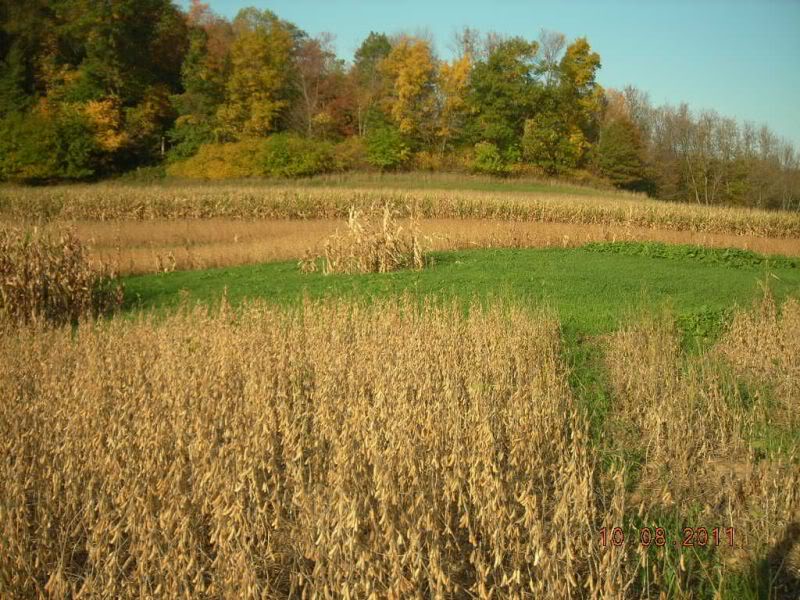
by night however it's another story and another reason to get trail cams out to see what is really going on!
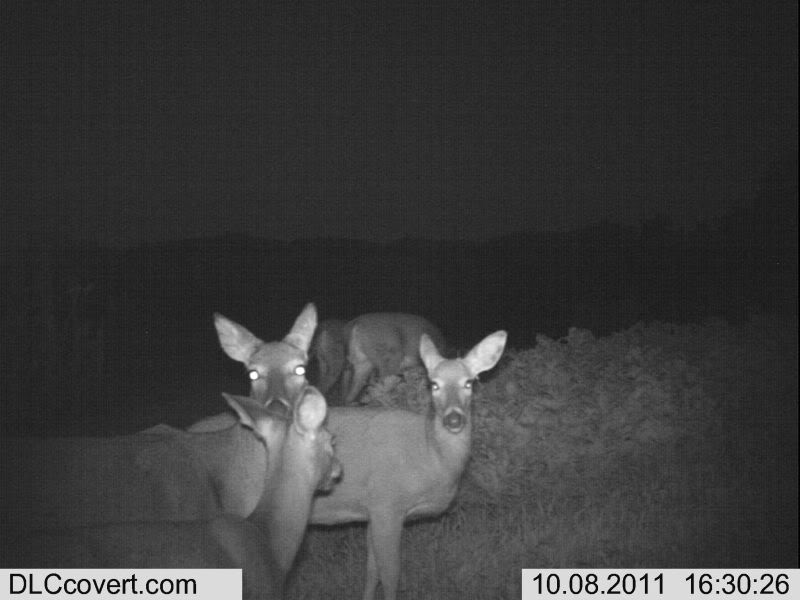
When the weather turns cold they are going to turn on Mikes soybeans with a vengeance which of course is why we use multiple crops in the same field to keep them coming year around. The rye will be there long after the beans are gone and keep them fed well into spring.
Get some trail cams out in your plots and find out what is really going on...

by night however it's another story and another reason to get trail cams out to see what is really going on!

When the weather turns cold they are going to turn on Mikes soybeans with a vengeance which of course is why we use multiple crops in the same field to keep them coming year around. The rye will be there long after the beans are gone and keep them fed well into spring.
Get some trail cams out in your plots and find out what is really going on...
dbltree
Super Moderator
October 18th, 2011
Well we've seen lot's of deer eating the winter rye/oats/peas/radish/clover salad bar...but what about the bucks??
Guess they give it the thumbs up too...

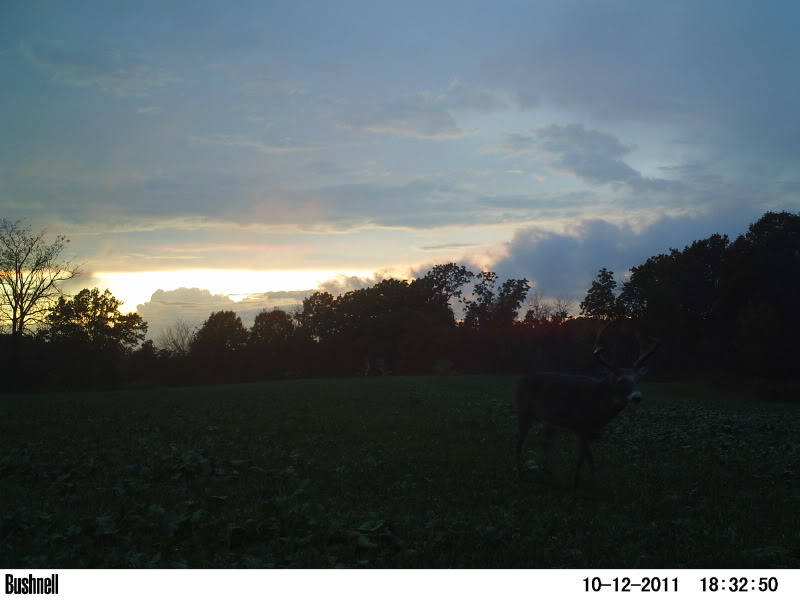
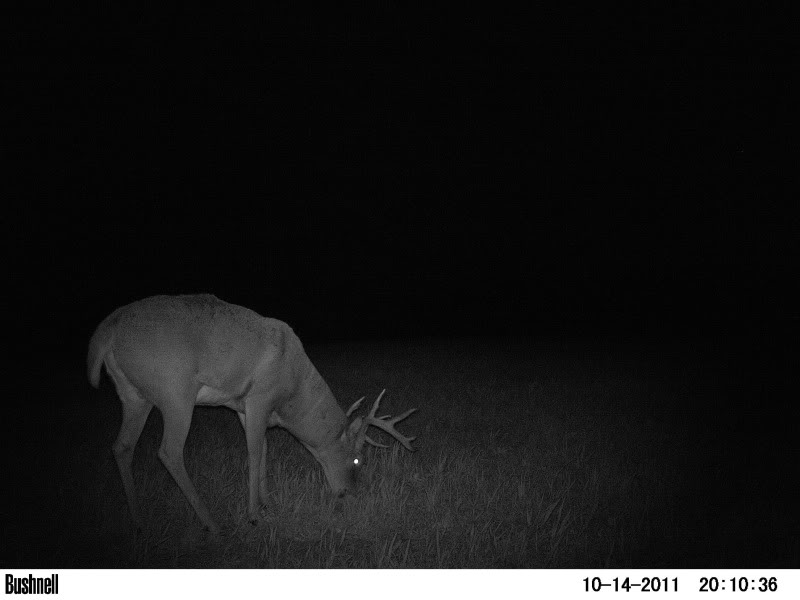
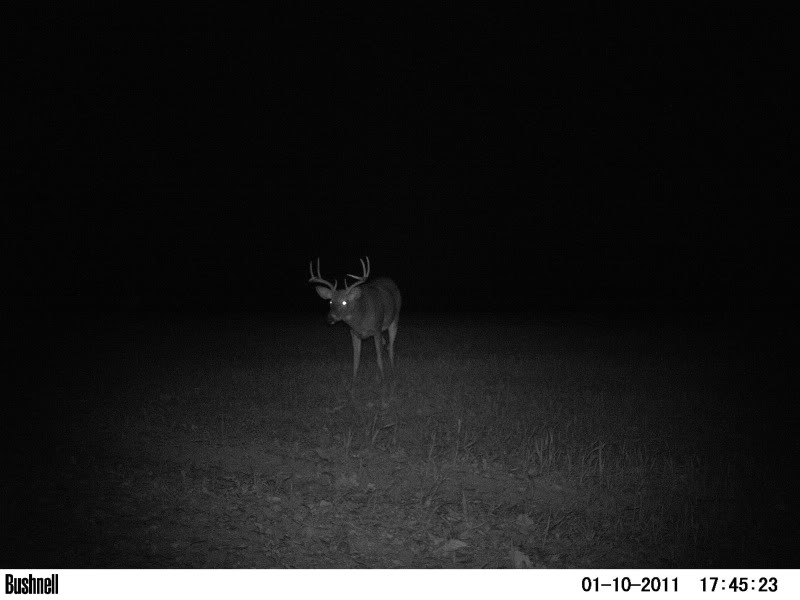
Soon...the last thing on any bucks mind will be eating anything at all but he will be where the does are...and I reckon we know where they'll be this fall...
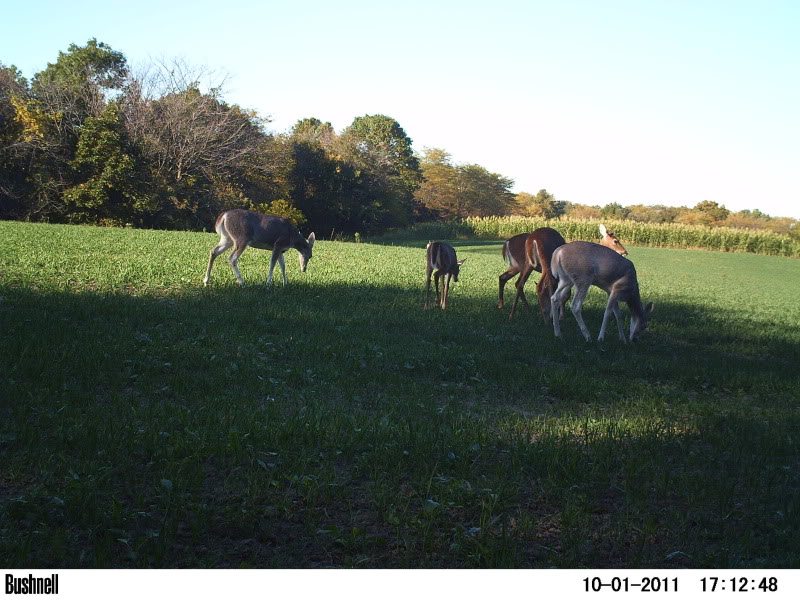
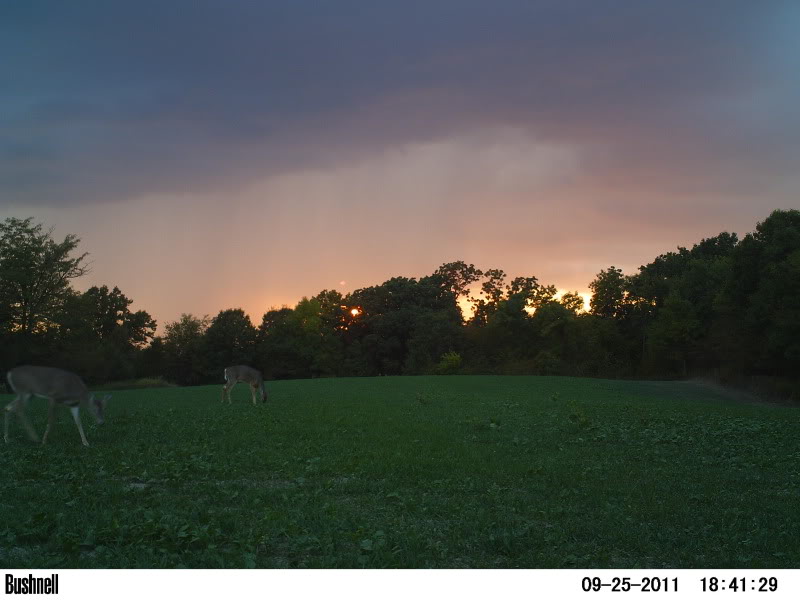
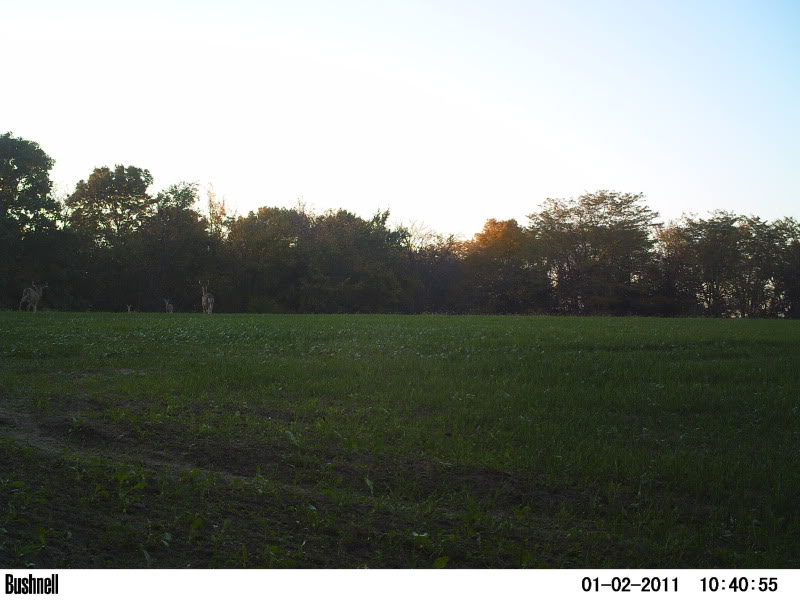
My friends in Pike County Illinois sent me this pic of their winter rye combination plot...yikes!

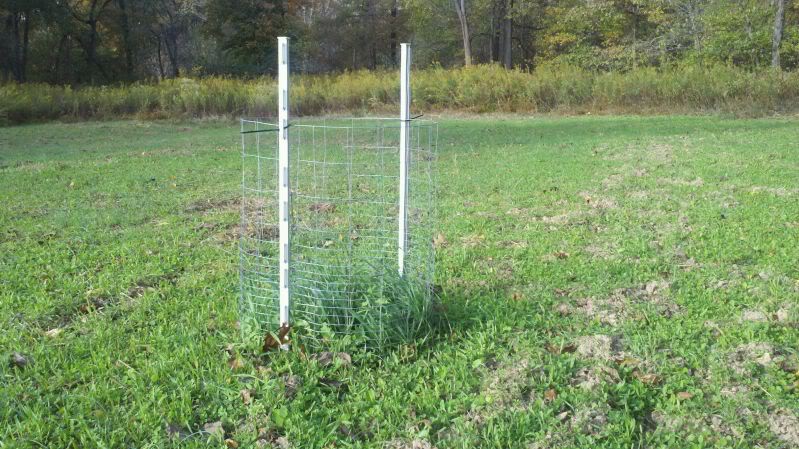
Guess they love rye in Illinois too...:way:
Well we've seen lot's of deer eating the winter rye/oats/peas/radish/clover salad bar...but what about the bucks??
Guess they give it the thumbs up too...




Soon...the last thing on any bucks mind will be eating anything at all but he will be where the does are...and I reckon we know where they'll be this fall...



My friends in Pike County Illinois sent me this pic of their winter rye combination plot...yikes!

Guess they love rye in Illinois too...:way:
Really wish I would have taken the time to up an exclusion cage on my winter rye/oats/peas/radish/clover plot so I could tell how well its growing, lesson learned. Due to lack of rain over the last two months and a huge increase in usage of the plot thanks to a combo of brassica, clover, corn and cereal strips the deer are keeping the cereal mix mowed down to half an inch or less. Hopefully it will last a couple more weeks till I can actually hunt it.
SCOFFIN
Miles Coffin
g. I. D..L. oxletemgo said:I have been really impressed with the winter rye I broadcast into the standing beans. They have been severely lacking rain yet they are looking great. Broadcast these when the b xG z Z Wu atyeans were turning
gls x .AWuxz z X
letemgrow
PMA Member
g. I. D..L. ox
gls x .AWuxz z X
I have a feeling my 2 year old helped me out with that post some. :grin:
dbltree
Super Moderator
I have been really impressed with the winter rye I broadcast into the standing beans. They have been severely lacking rain yet they are looking great. These were broadcast when the beans were turning.

Nice work Phil! Thanks for posting that pic (with the help of your 2 yr old of course...
October 26th, 2011
Tough year for food plots in SE Iowa this year but despite the powder dry soils the winter rye/oats/peas and radish are holding their own...well...in some cases at least the rye and oats are still there! This is the first field I planted roughly 90 days ago....

and deer are keeping it hammered to the ground!
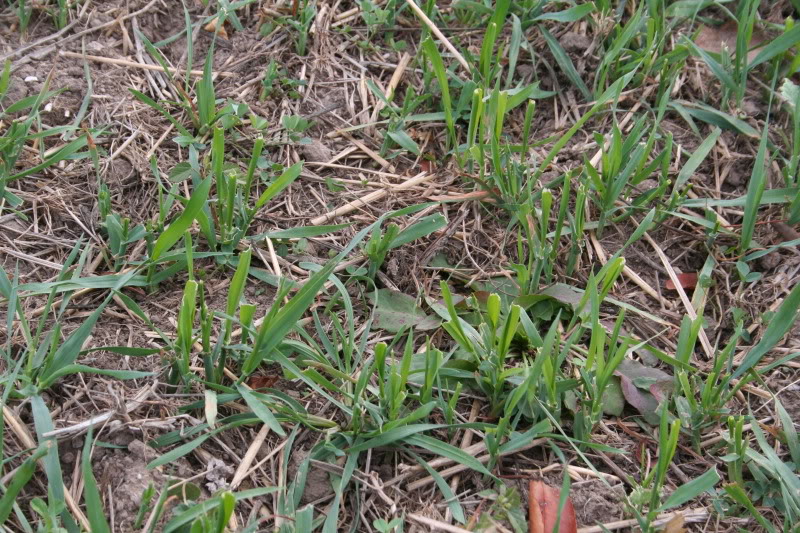
The peas and radish are all but gone here already!
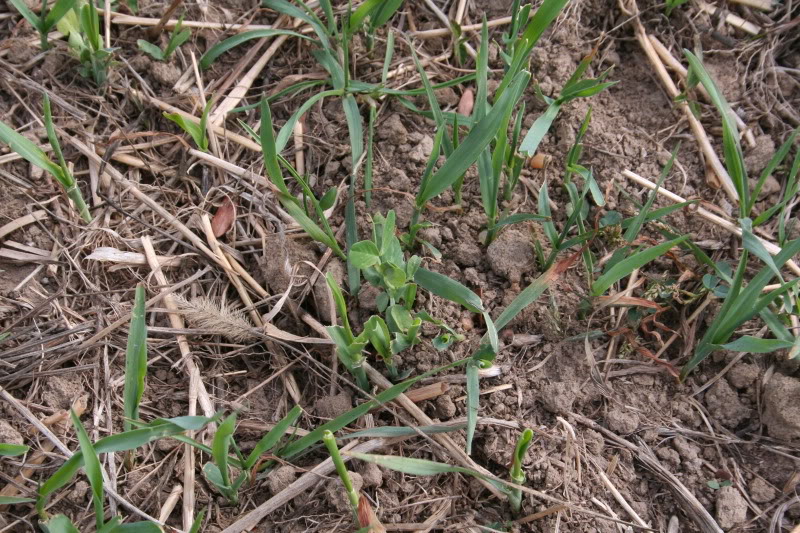
There always comments now and then about "deer like this cereal better then that" but you will never see any of it a different height then the other...they graze both rye and oats evenly...and in this case the forage radish gets the extra "nip"! Note the little red clover seedlings...

the trail cams reveal the reason for the well "mowed" plot...
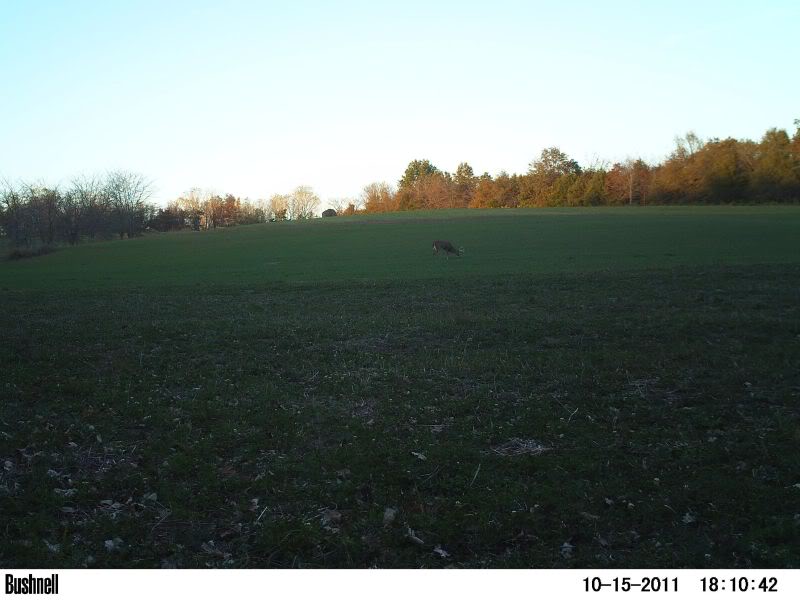
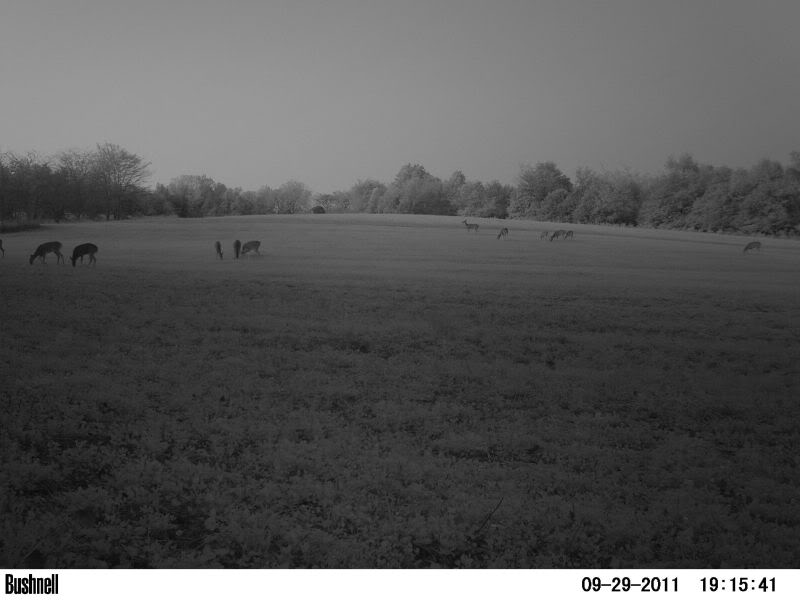
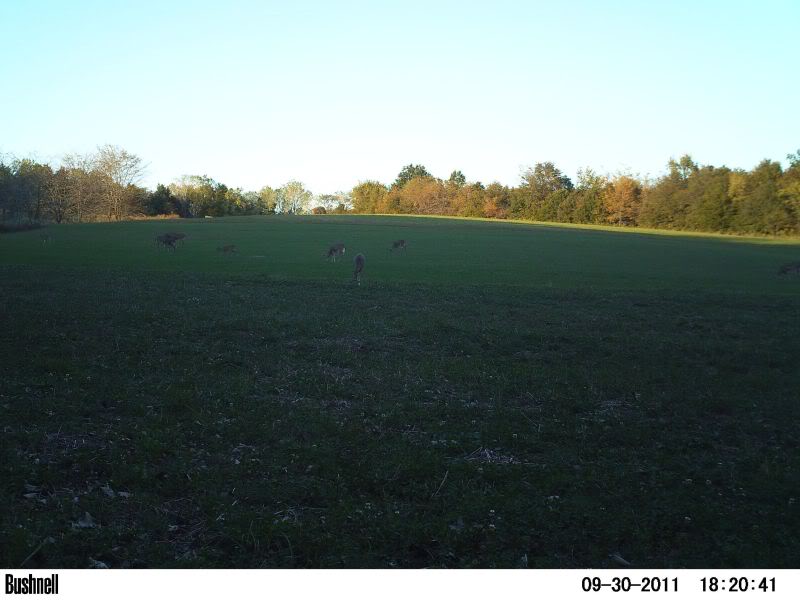

In larger fields the rye/oat/pea/radish/clover combination is holding up a little better
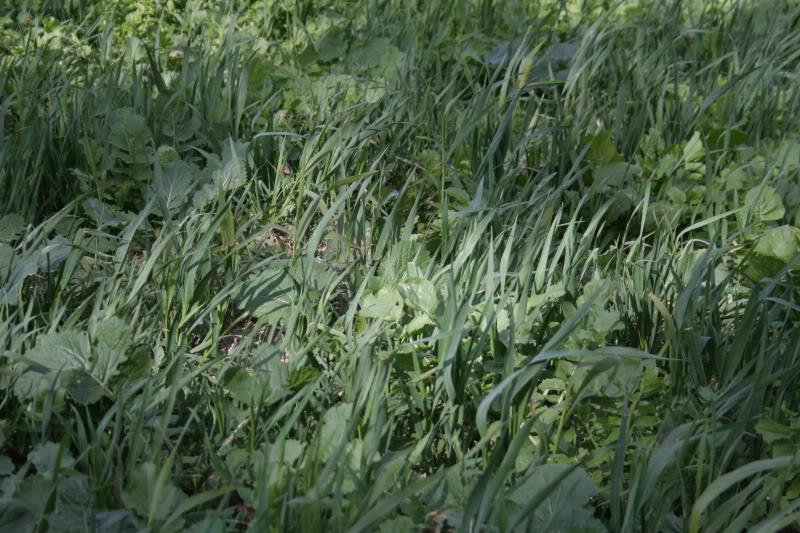
the Groundhog forage radish at least has a chance to grow a bit

and the Austrian winter peas are hanging in there
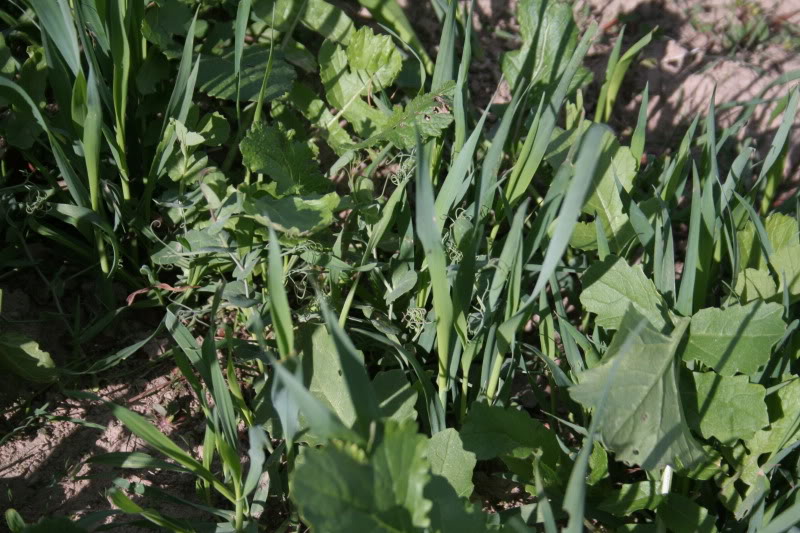
but plenty of grazing going on!
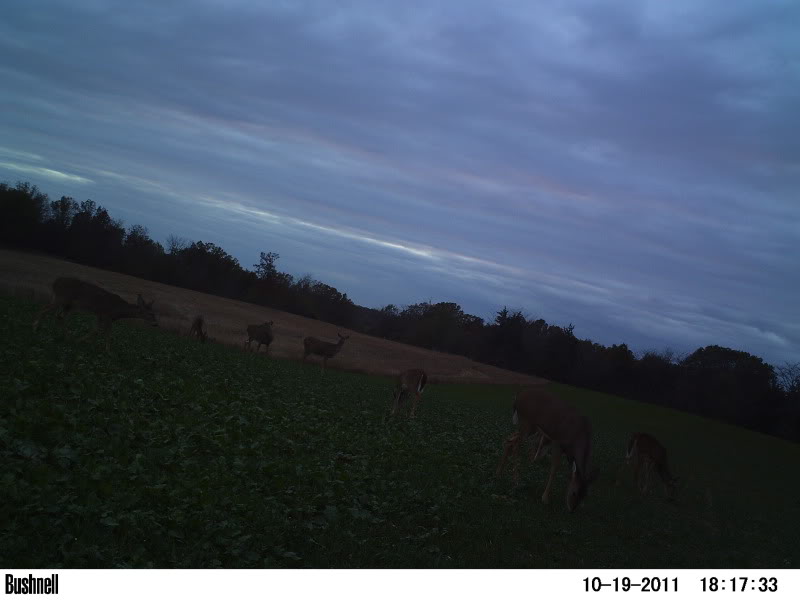
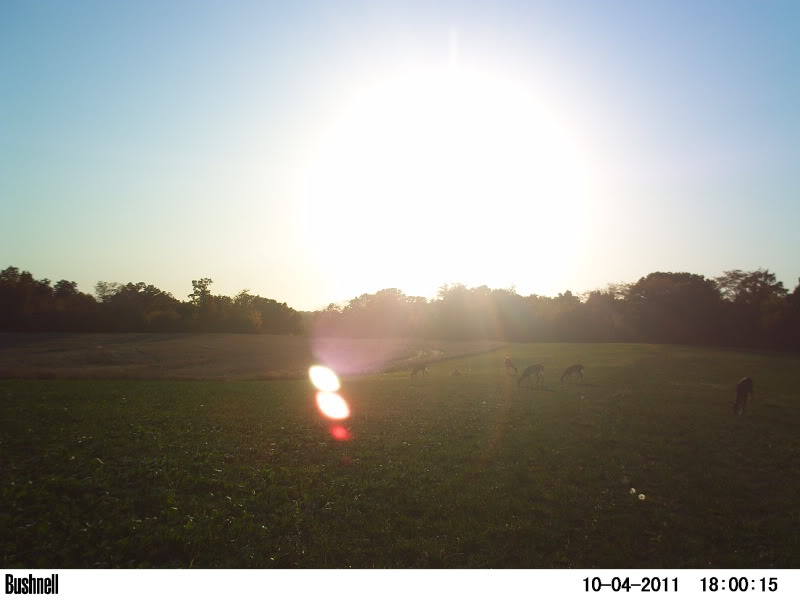
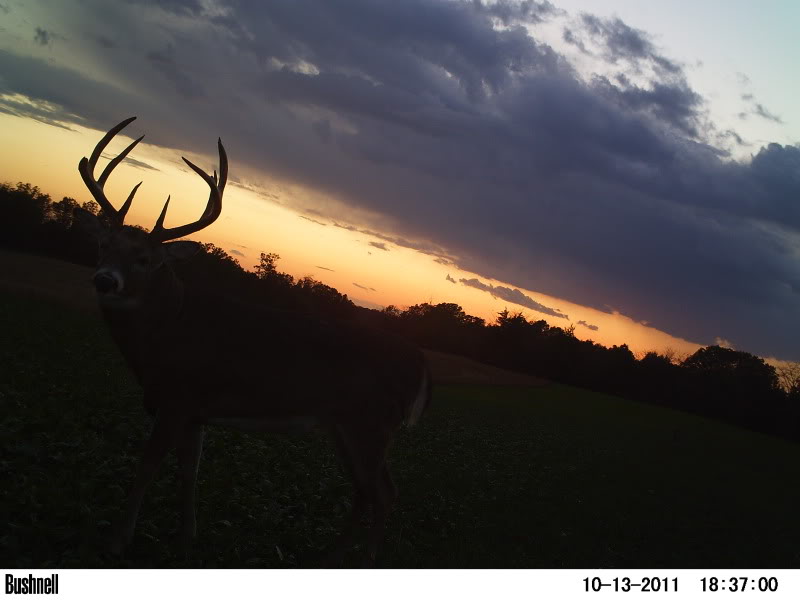

This is the last field planted...took forever to come up because it missed getting the rains the other fields did yet slowly but surely the plot is greening up!
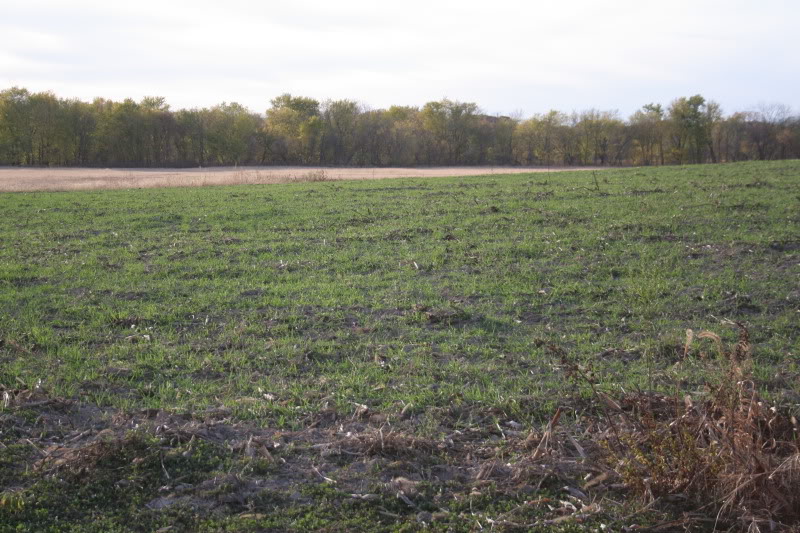
In every plot on every farm there is evidence of grazing
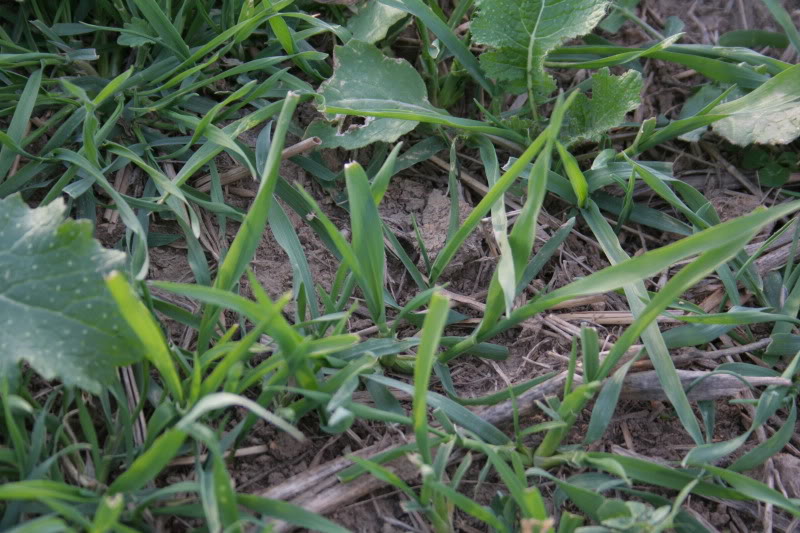
This is a sample of why it is really fruitless to plant rape and turnips with cereals...they just don't have enough time to put on any growth compared to July plantings. These are here only because they failed to germinate on July due to zero rainfall...and came up with rain in September after being re-planted to rye

Every field looks like this...
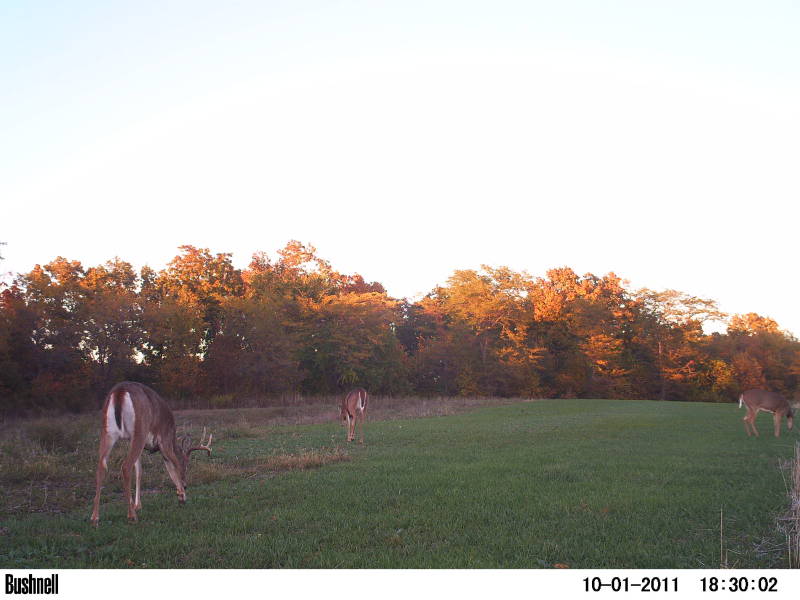
Bucks...

no where the does will be
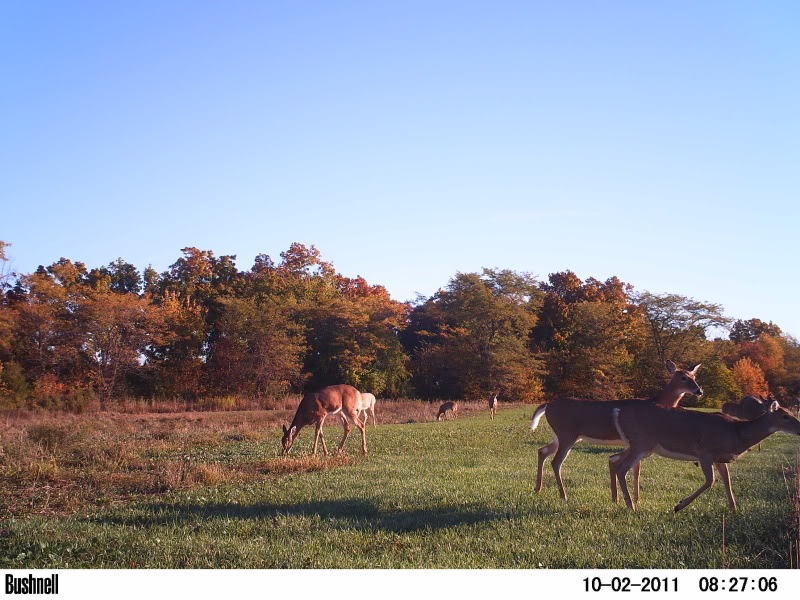
We haven't had rain in weeks...yet the winter rye/oat/pea/radish combination is attracting and holding whitetails and will be all winter and into spring....at which point the red clover will hold them until I till it under for a rotation to brassicas.

Fields that were planted before we got 2" of rain on August 30th have great stands of both white and red clover...those planted afterwards I think the clover in some areas may have germinated and died. To be safe I'll frost seed additional clover in late winter so check your stands when you can....
How mnay acres are the fields you plant the rye mix in? I am going to modify some of the areas on my farm next year. I have one field that is 2 acres that is surrounded by timber. It is half clover/chicory and half brasicas and oats this year. I was thinking of putting it into 3 strips next year, one clover/chicory, one straight brassicas, and one in something similiar to yor rye mix. What do you think? I have another field that is one acre, would it be wise to do the same as above on a smaller scale?
dbltree
Super Moderator
How many acres are the fields you plant the rye mix in? I am going to modify some of the areas on my farm next year. I have one field that is 2 acres that is surrounded by timber. It is half clover/chicory and half brassicas and oats this year. I was thinking of putting it into 3 strips next year, one clover/chicory, one straight brassicas, and one in something similar to your rye mix. What do you think? I have another field that is one acre, would it be wise to do the same as above on a smaller scale?
Every feeding area I plant on my own land or for others is divided into strips or blocks that include individual plantings of white clover, brassicas and the rye mix.
That includes areas as small as a large garden or as big as a ten acre field but larger areas do not need to be a 1/3 clover. I generally plant 10-20% to white clover and divide the rest between brassicas and the rye combo.
Your on the right track with your plans...:way:
dbltree
Super Moderator
November 3rd, 2011
We try to stay out of the food plots this time of year but I had to check a couple cams on the outer edges of some fields and took a few pics while there. Keep in mind these are the spots with the least grazing simply because they are the farthest from bedding and have the least screening.
The winter rye, oats, Austrian, Winter Pea, Groundhog Forage Radish, red clover mix....
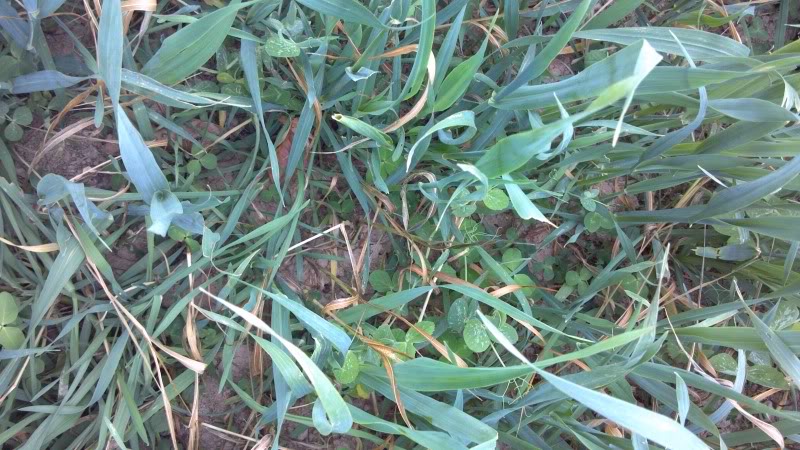
This pics shows all of the components of this "deer salad"...like the radish, peas are also "deer candy" and very attractive to deer.

Here is why I add the GHFR...deer focused on the rye and oats early on but now the GHFR has reached a height that deer find irresistible and they have turned on it with a vengeance!
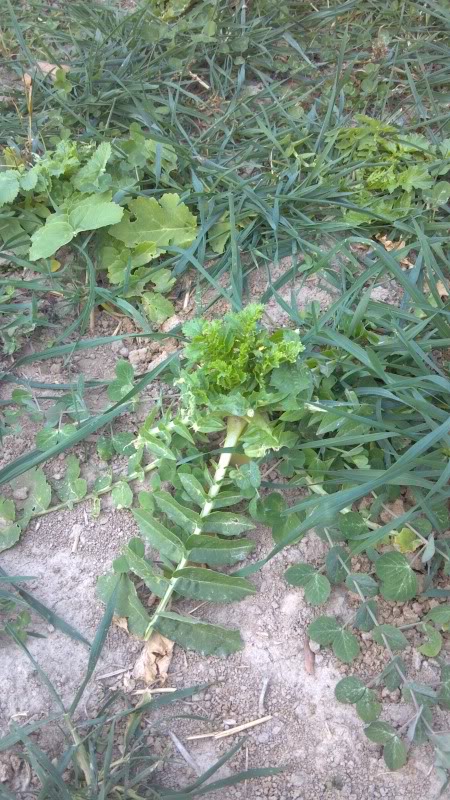
Like winter rye...there is the added advantage of the fact that forage radish plants are also nitrogen scavengers
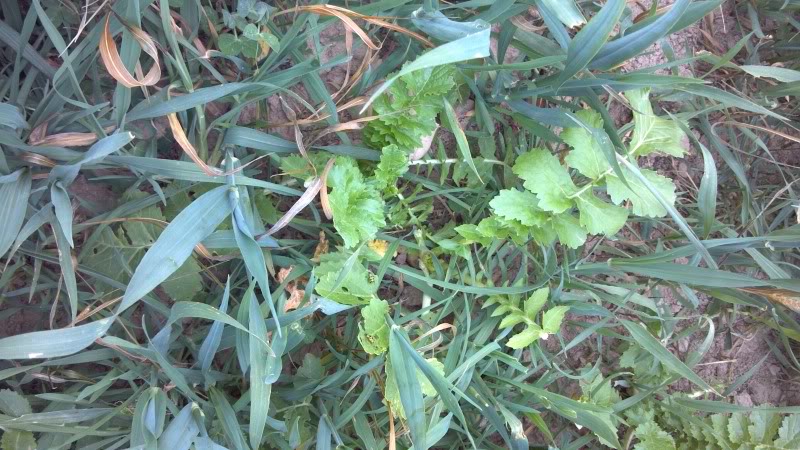
as well as having allelopathic chemicals that help control weeds the following spring and the roots help break up compacted soils.
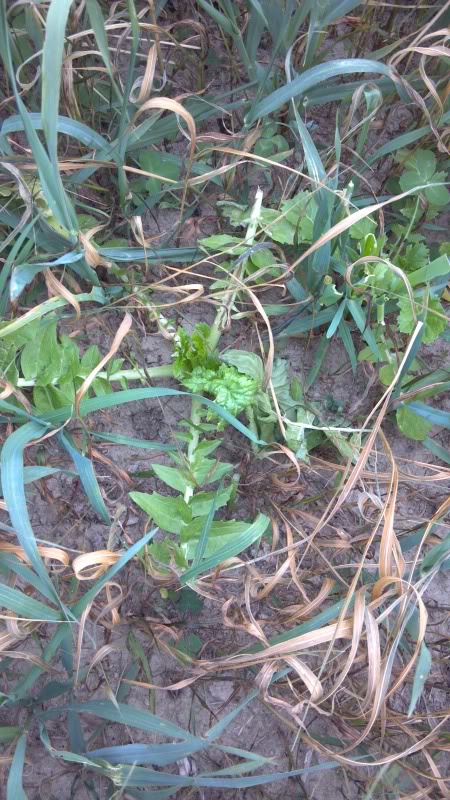
The clovers...I cannot stress enough the importance of adding clovers to this mix in the fall!
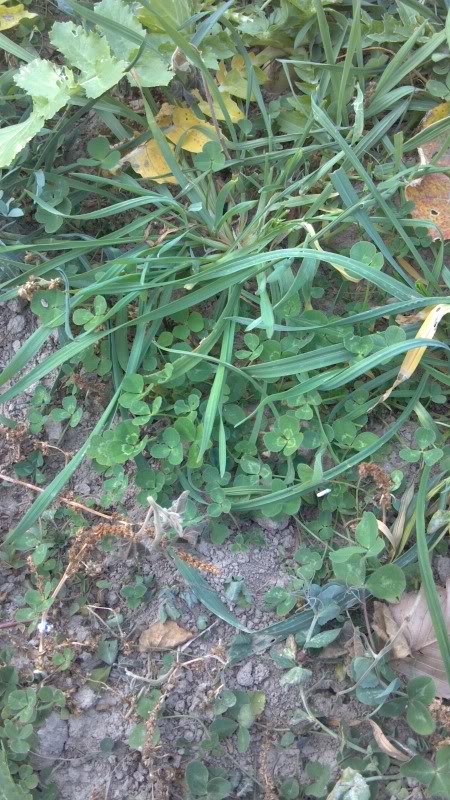
Use white, red or alsike...white for perennial clover and red if you plan to rotate this to brassicas the following summer
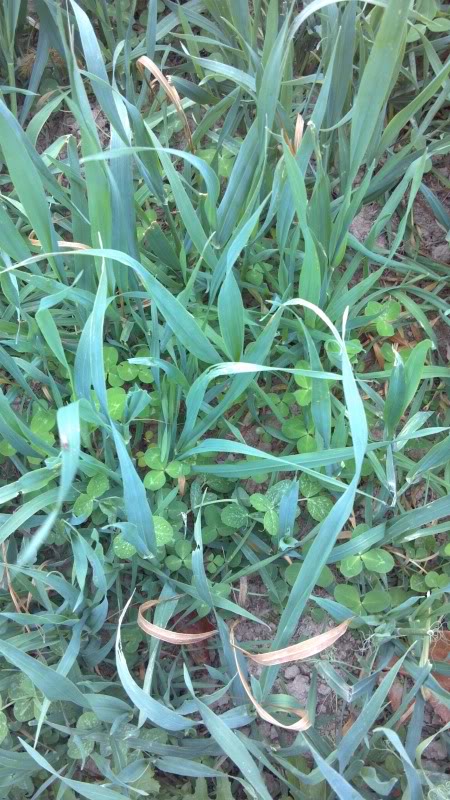
We have had temps down to 25 degrees which killed the annual weed grasses like foxtail but has had zero effect on the oats and of course rye is the most winter hardy of all cereals.
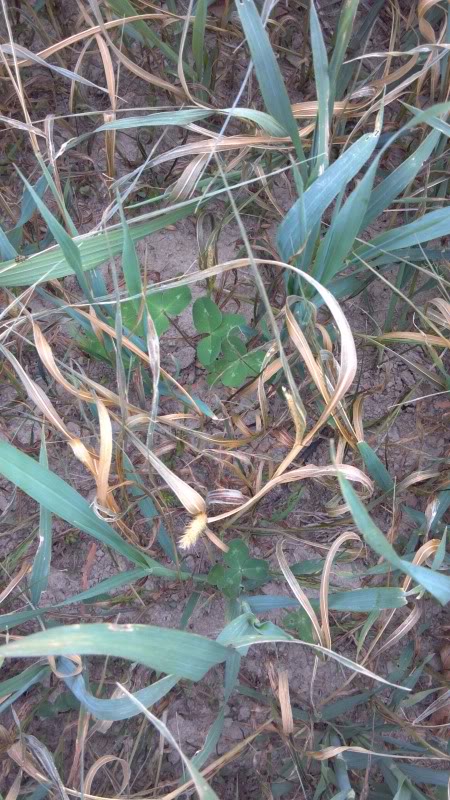
The clovers are already well established and will require no weed control next spring because they, along with the winter rye will quickly suffocate weeds.
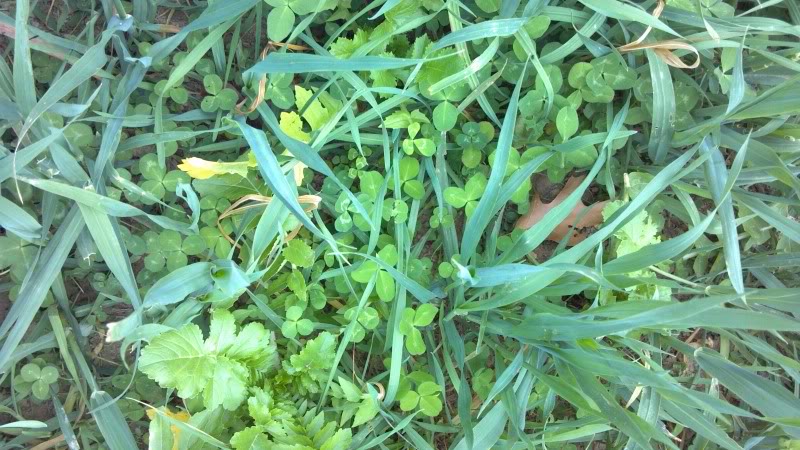
Despite having the least protective surrounding cover, these fields of the rye combination mix are covered up with deer!
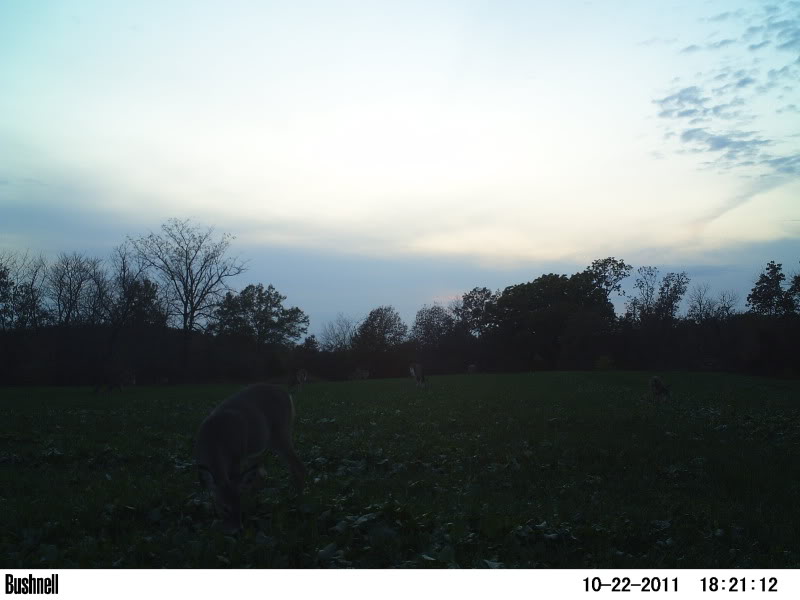
and even rutting bucks can't resist feeding on it!

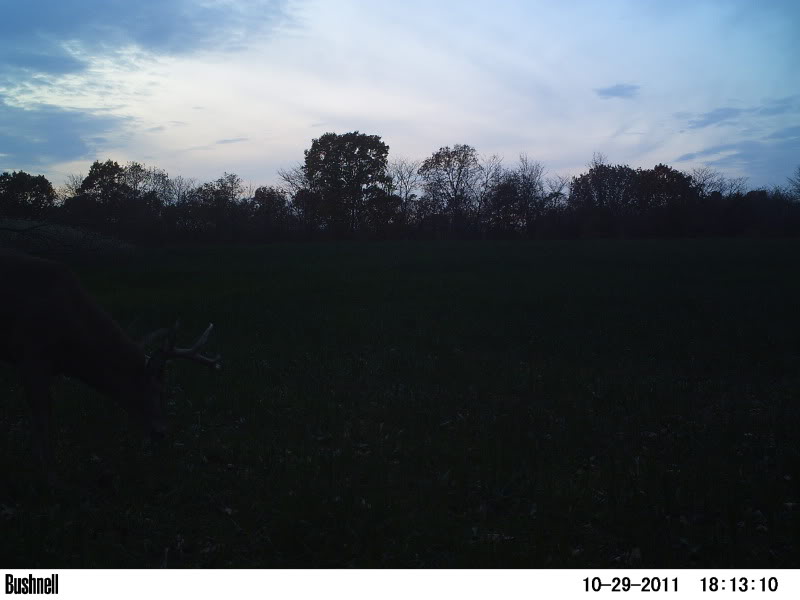
This the first year for these plots and for these deer feeding on this mix

In areas overloaded with food sources however it can take deer a year or two to adapt to feeding in any plot, planted to almost any crop.
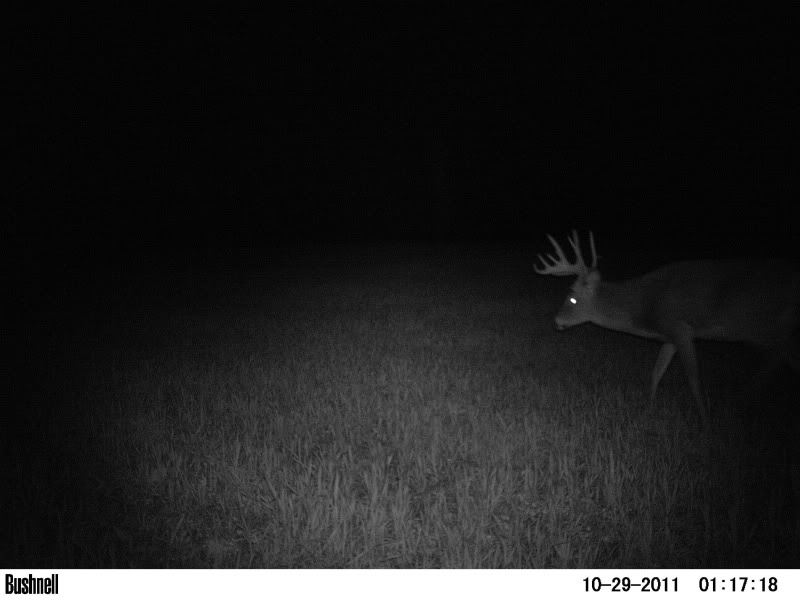
Grant Woods noted that because deer in his area were not accustomed to eating soybeans, they scarcely touched them the first year but over the coming years they soon adapted to not only the beans but the feeding place itself and eventually started wiping them out.
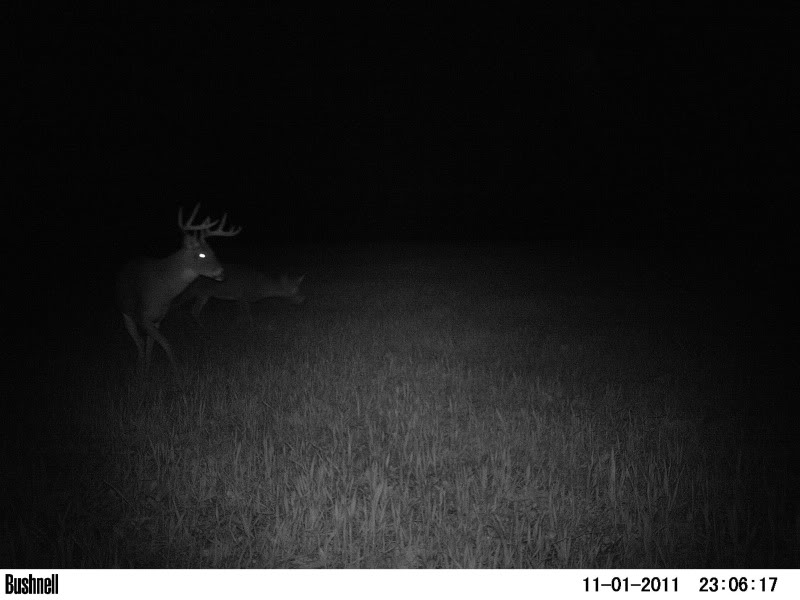
There are many many variables involved when comparing crop types and each landowner should keep that in mind. Provide multiple food sources in ONE place (per 80-120 acres), provide them year around, be certain the feeding area is screened and safe and allow the deer several years to adapt to feeding there before passing judgment. Like Grant, in time you will find that deer will likely begin wiping out whatever you plant...and this mix is one of the few that can take the punishment of heavy grazing and if clover is included STILL provide year around food sources.
Consider adding the rye/oats/peas/radish/clover mix to your habitat arsenal...your deer will be glad you did... :way:
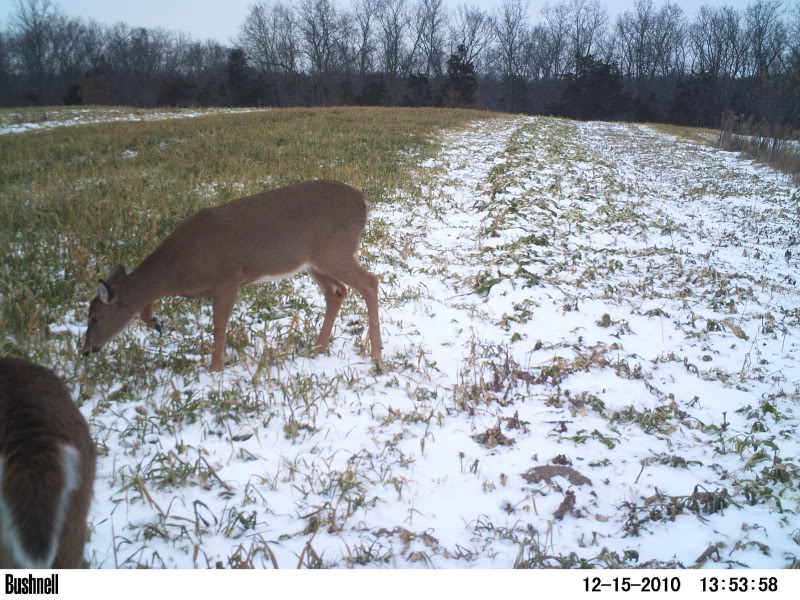
We try to stay out of the food plots this time of year but I had to check a couple cams on the outer edges of some fields and took a few pics while there. Keep in mind these are the spots with the least grazing simply because they are the farthest from bedding and have the least screening.
The winter rye, oats, Austrian, Winter Pea, Groundhog Forage Radish, red clover mix....

This pics shows all of the components of this "deer salad"...like the radish, peas are also "deer candy" and very attractive to deer.

Here is why I add the GHFR...deer focused on the rye and oats early on but now the GHFR has reached a height that deer find irresistible and they have turned on it with a vengeance!

Like winter rye...there is the added advantage of the fact that forage radish plants are also nitrogen scavengers

as well as having allelopathic chemicals that help control weeds the following spring and the roots help break up compacted soils.

The clovers...I cannot stress enough the importance of adding clovers to this mix in the fall!

Use white, red or alsike...white for perennial clover and red if you plan to rotate this to brassicas the following summer

We have had temps down to 25 degrees which killed the annual weed grasses like foxtail but has had zero effect on the oats and of course rye is the most winter hardy of all cereals.

The clovers are already well established and will require no weed control next spring because they, along with the winter rye will quickly suffocate weeds.

Despite having the least protective surrounding cover, these fields of the rye combination mix are covered up with deer!

and even rutting bucks can't resist feeding on it!


This the first year for these plots and for these deer feeding on this mix

In areas overloaded with food sources however it can take deer a year or two to adapt to feeding in any plot, planted to almost any crop.

Grant Woods noted that because deer in his area were not accustomed to eating soybeans, they scarcely touched them the first year but over the coming years they soon adapted to not only the beans but the feeding place itself and eventually started wiping them out.

There are many many variables involved when comparing crop types and each landowner should keep that in mind. Provide multiple food sources in ONE place (per 80-120 acres), provide them year around, be certain the feeding area is screened and safe and allow the deer several years to adapt to feeding there before passing judgment. Like Grant, in time you will find that deer will likely begin wiping out whatever you plant...and this mix is one of the few that can take the punishment of heavy grazing and if clover is included STILL provide year around food sources.
Consider adding the rye/oats/peas/radish/clover mix to your habitat arsenal...your deer will be glad you did... :way:

dbltree
Super Moderator
November 6th, 2011
The rut...the time we all wait for! While providing food year around is crucial to adapting deer to living on our property, providing an attractive, impossible to resist food source food source in November is critical. There are of course many crops that can fill this need and ideally we will have those crops planted strips or blocks within one centrally located feeding area.
Winter rye, oats, forage peas, forage radish and either white or red clover is one crop mix that whitetails find irresistible and cameras reveal what we are not always there to see in person....
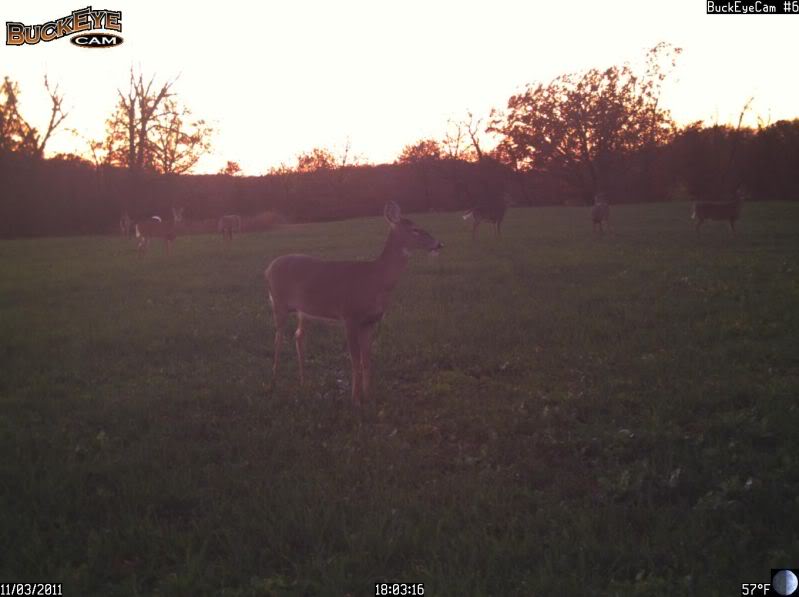
Boat loads of deer...here feeding behind an Egyptian Wheat screen....
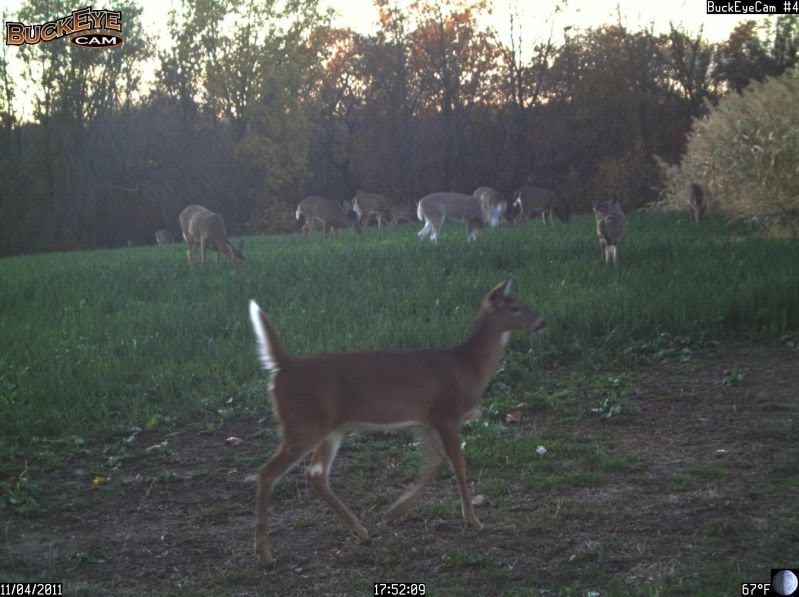
Big mature bucks are not interested in feed now...but what they are interested in...is feeding on the rye combination...
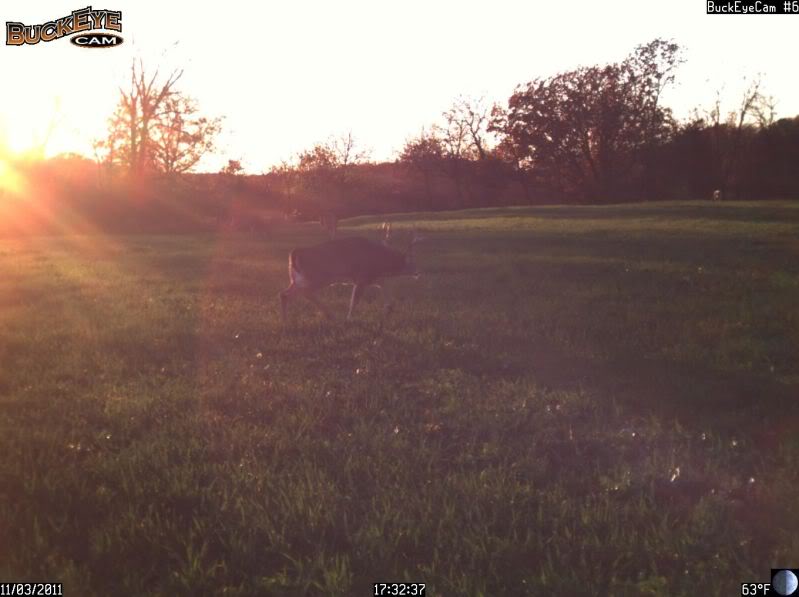
On this farm the landowner is able to monitor the success of his plots via Buckeye cams that remotely send pictures to his computer without bothering deer using the food sources. Day and night they silently send information that helps him better manage his habitat and whitetails and though he has never had the rye combination mix planted on any of his farms in the past...you can rest assured he'll want it included every year from now on....
The rut...the time we all wait for! While providing food year around is crucial to adapting deer to living on our property, providing an attractive, impossible to resist food source food source in November is critical. There are of course many crops that can fill this need and ideally we will have those crops planted strips or blocks within one centrally located feeding area.
Winter rye, oats, forage peas, forage radish and either white or red clover is one crop mix that whitetails find irresistible and cameras reveal what we are not always there to see in person....

Boat loads of deer...here feeding behind an Egyptian Wheat screen....

Big mature bucks are not interested in feed now...but what they are interested in...is feeding on the rye combination...

On this farm the landowner is able to monitor the success of his plots via Buckeye cams that remotely send pictures to his computer without bothering deer using the food sources. Day and night they silently send information that helps him better manage his habitat and whitetails and though he has never had the rye combination mix planted on any of his farms in the past...you can rest assured he'll want it included every year from now on....
dbltree
Super Moderator
November 18th, 2011
Flip side of the rut here in SE Iowa, still some bucks locked down with does while others are on a desperate cross country search for another hot doe. The constant harassment however changes the routines of the doe groups who tire of being chased relentlessly and are more cautious about entering feeding areas. Still, they are hungry and slip out into the plots in smaller groups or individuals to grab a bite before diving back into the brush...
Tuesday morning it was 26 and Wednesday morning it was 19 yet the winter rye, oats, peas, radish and clover combo remains vibrant, healthy green and growing! Winter rye is of course the most winter hardy winter cereal and will continue growing when other cereals like wheat have stopped and then start growing again in very early spring, again before wheat does....these traits help make winter rye and invaluable cornerstone in this mix.
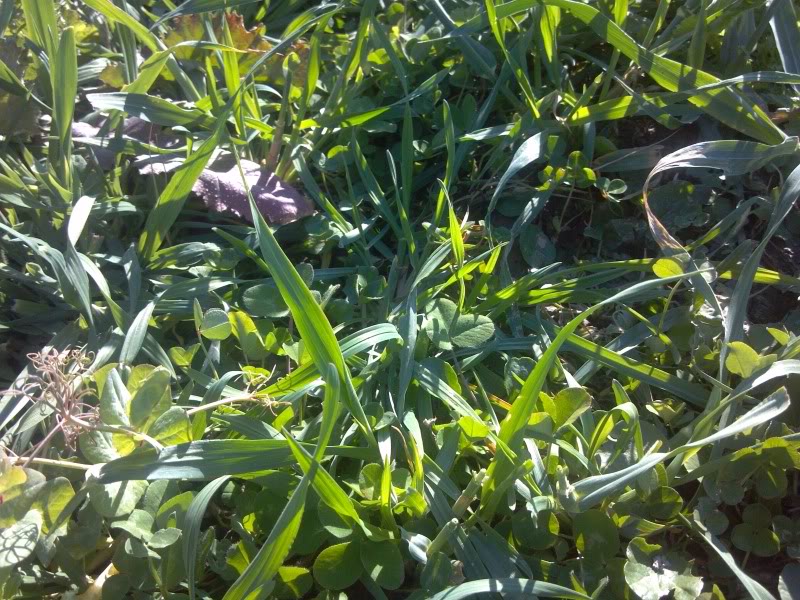
Contrary to what you read in the ads most common oats are very cold tolerant and will usually last well into early to mid December here in southern Iowa. While I use oats such as Jerry or Jim, almost any will work well and are very affordable, yet highly attractive forages in this mix. The reason I add oats is because they will in fact freeze out, leaving only the rye behind which planted at only 50-60#'s per acre will not suffocate the seedling clovers in the spring.
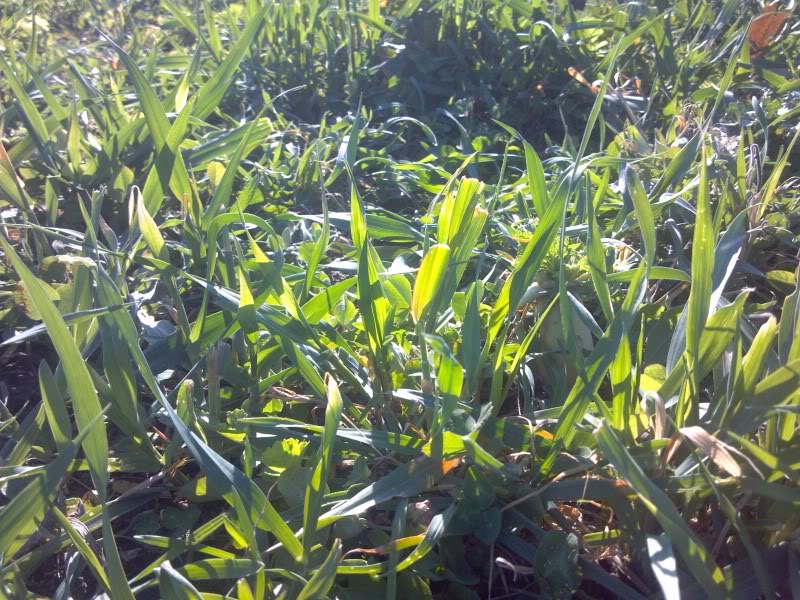
The Groundhog forage radish has now been eaten to the root on almost every plant and as cold weather moves in, they will devour every single root eating it right to the soil. If that were not enough...the root will decompose allowing water to flow in the channels and the freezing and thawing will pulverize compacted soils. The decaying roots will also leave behind scavenged nitrogen...all of which make the GHFR and indispensable tool in this outstanding mix of great forage and cover crops.
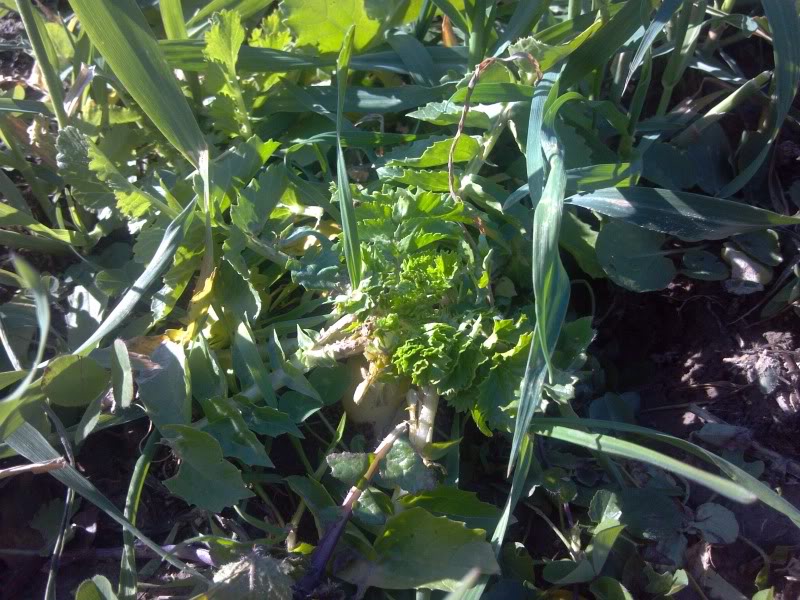
Deer have beaten down runways going into these plots despite having fields of freshly combined corn and soybeans to feed in only a hundred yards away.
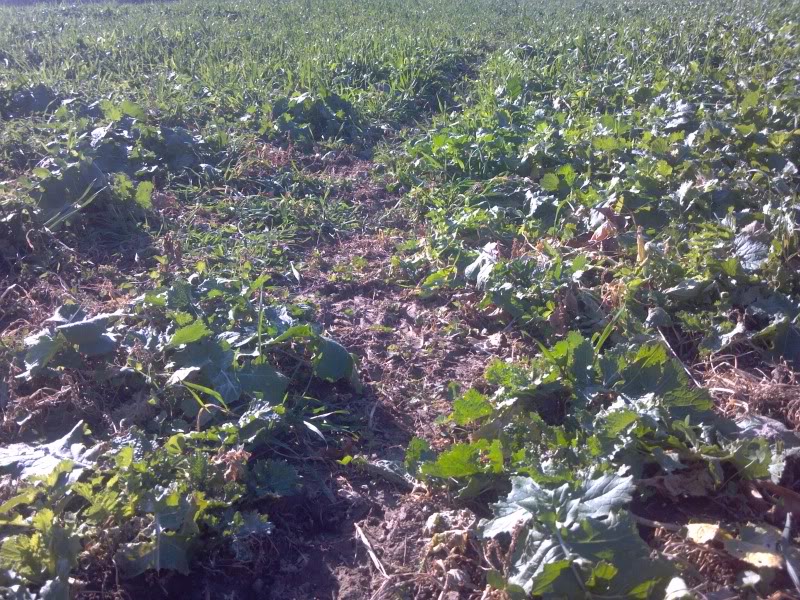
The area were brassicas came up (that didn't during the drought) are being eaten, yes...but they offer a fraction of the forage that July planted brassicas do with little or no root growth. Secondly they have suffocated the cereals and clovers out so for best results add 5#'s of GHFR to your rye mix but plant the typical brassica mix in mid summer in separate strips within the same plot and then rotate yearly.
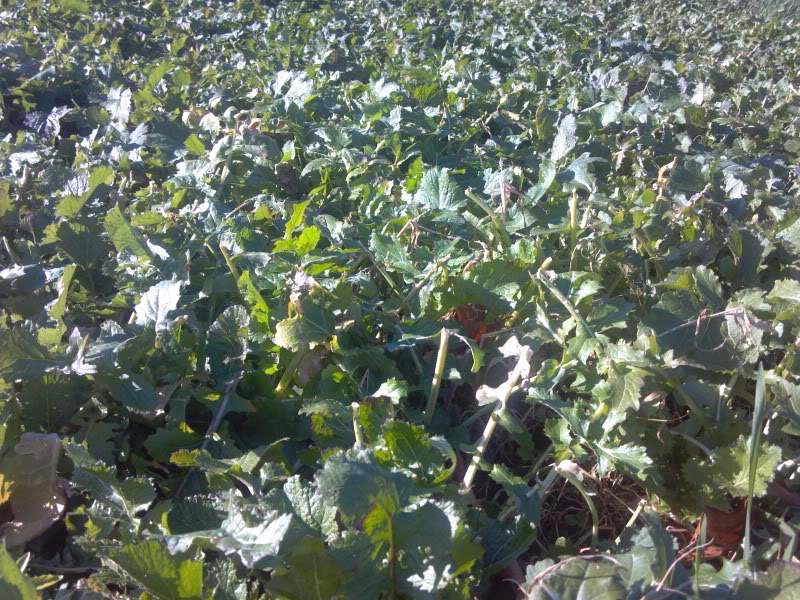
It's easy to see the field has been trampled and heavily grazed
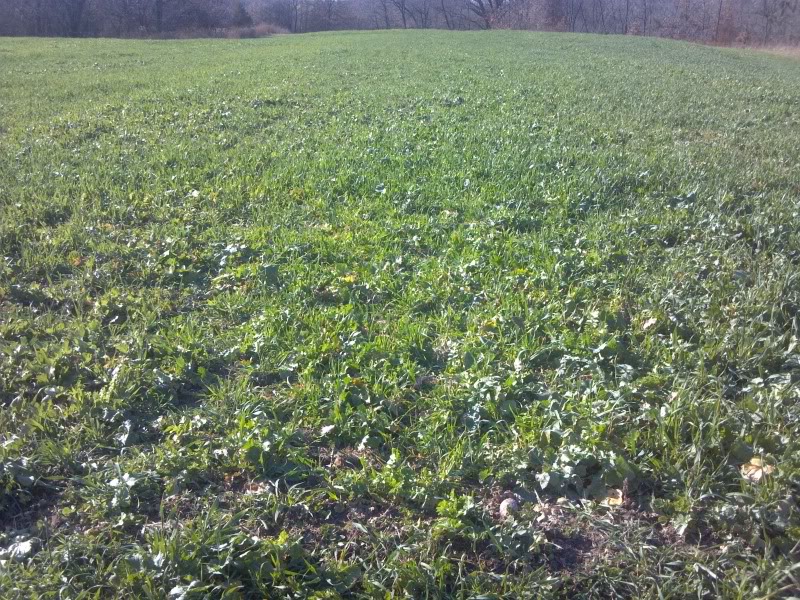
This mix is so effective I sometimes wonder why I bother with electric fences and soybeans!

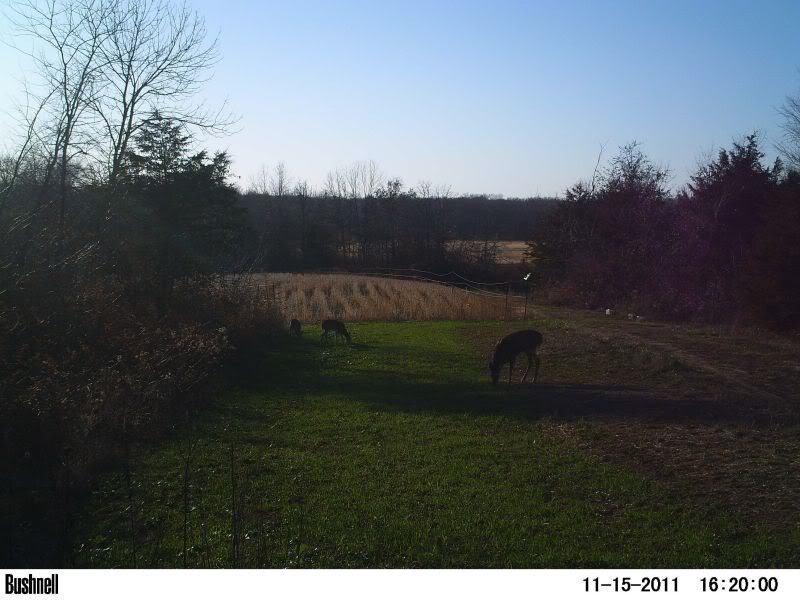
Note some deer are feeding in the beans but they all end up in the rye even though they are chest deep in soybeans!
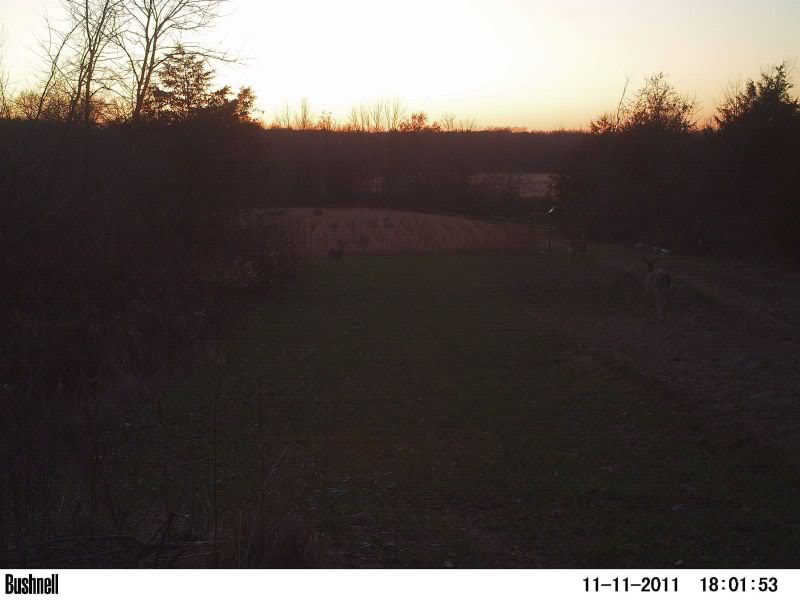
These are situations where deer have a clear choice and for now prefer the rye mix
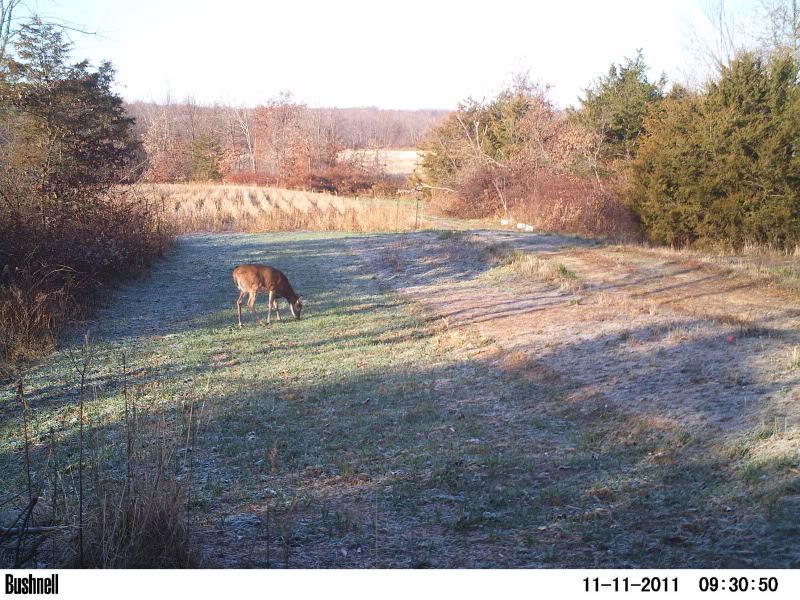
Bucks of course could care less about either and have one thing on their minds but show up daily/nightly looking for does they know will be feeding there.
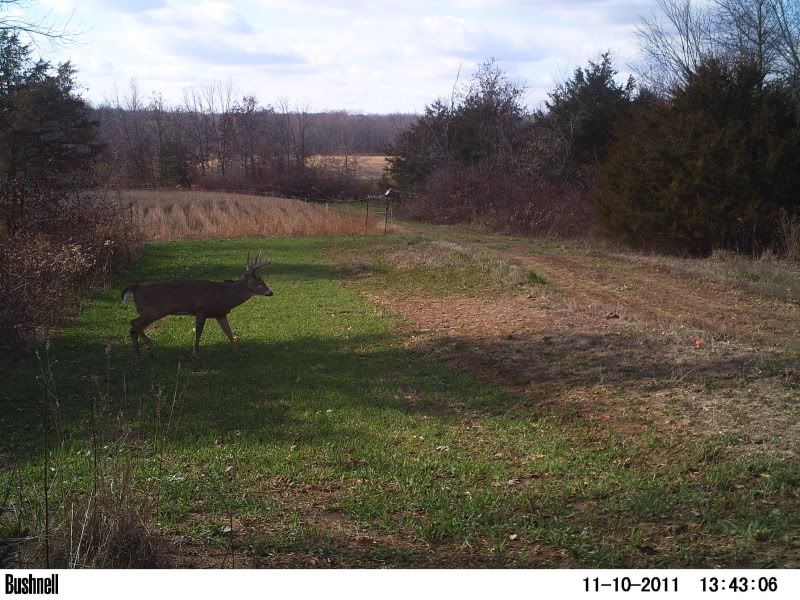
The older mature bucks are most efficient at finding does in estrous and least likely to show up for another week or two but the younger bucks appear one after another...
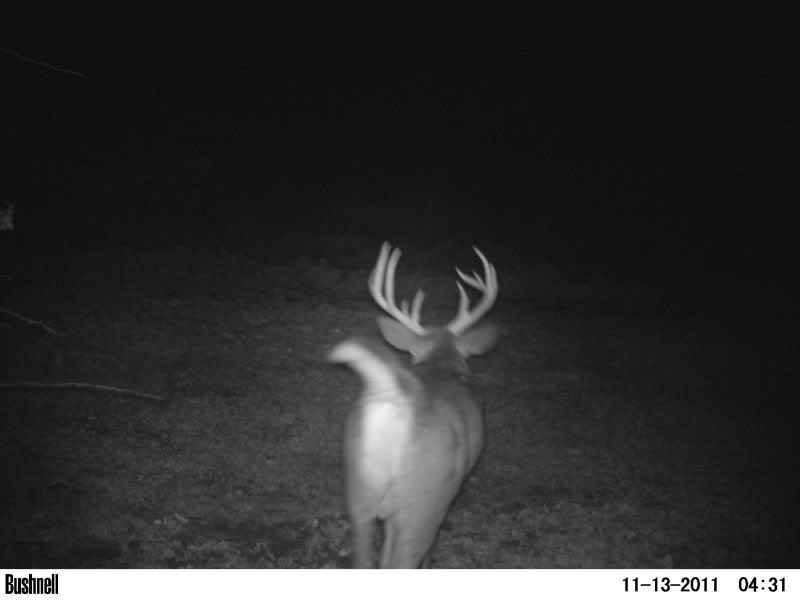
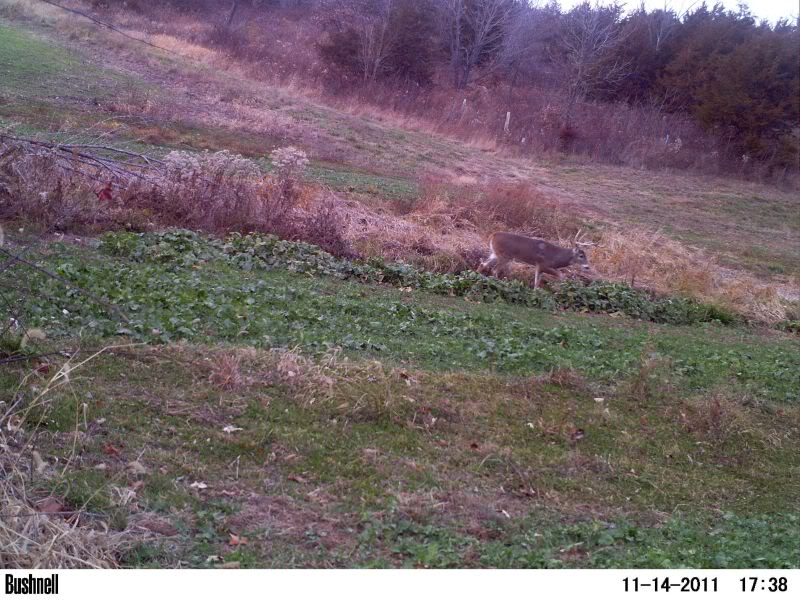
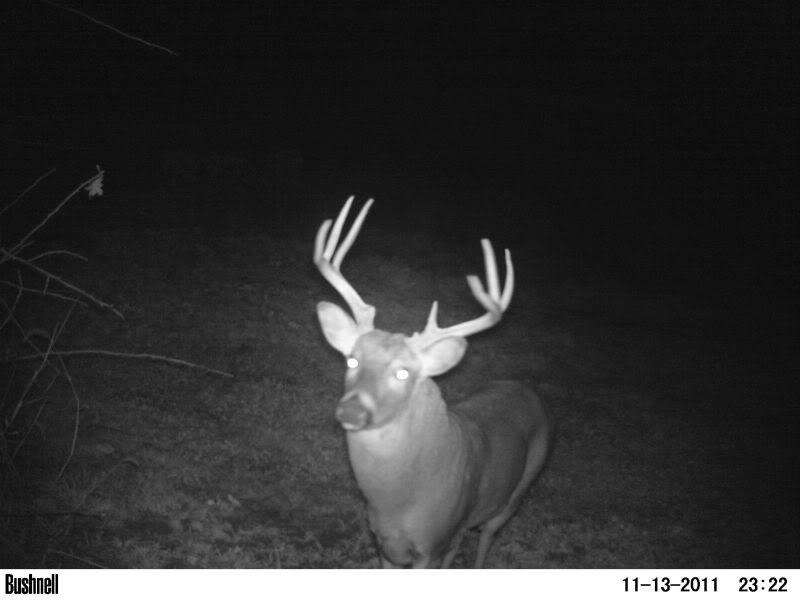
Plant multiple food sources within one centralized feeding area, that in combination will provide food YEAR AROUND, next to premium thick cover...and over time deer will adapt to this and you will successfully attract and hold whitetails.
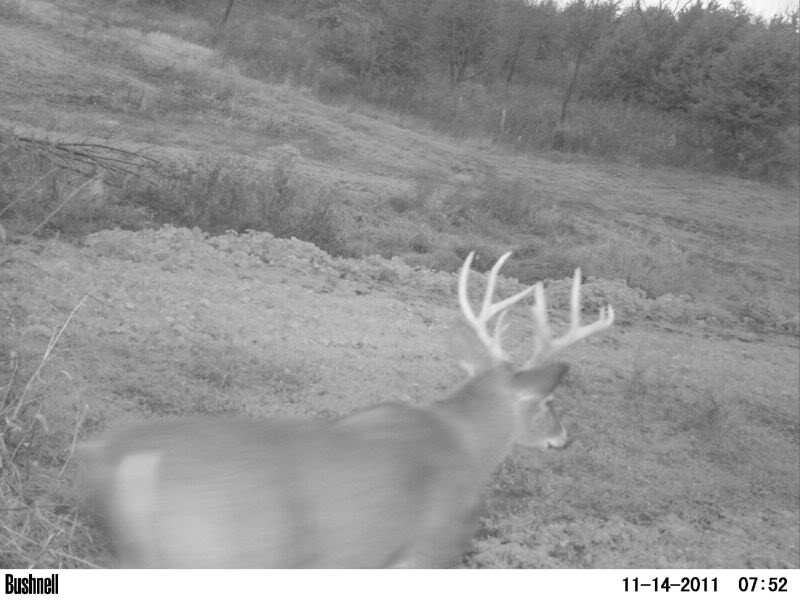
Flip side of the rut here in SE Iowa, still some bucks locked down with does while others are on a desperate cross country search for another hot doe. The constant harassment however changes the routines of the doe groups who tire of being chased relentlessly and are more cautious about entering feeding areas. Still, they are hungry and slip out into the plots in smaller groups or individuals to grab a bite before diving back into the brush...
Tuesday morning it was 26 and Wednesday morning it was 19 yet the winter rye, oats, peas, radish and clover combo remains vibrant, healthy green and growing! Winter rye is of course the most winter hardy winter cereal and will continue growing when other cereals like wheat have stopped and then start growing again in very early spring, again before wheat does....these traits help make winter rye and invaluable cornerstone in this mix.

Contrary to what you read in the ads most common oats are very cold tolerant and will usually last well into early to mid December here in southern Iowa. While I use oats such as Jerry or Jim, almost any will work well and are very affordable, yet highly attractive forages in this mix. The reason I add oats is because they will in fact freeze out, leaving only the rye behind which planted at only 50-60#'s per acre will not suffocate the seedling clovers in the spring.

The Groundhog forage radish has now been eaten to the root on almost every plant and as cold weather moves in, they will devour every single root eating it right to the soil. If that were not enough...the root will decompose allowing water to flow in the channels and the freezing and thawing will pulverize compacted soils. The decaying roots will also leave behind scavenged nitrogen...all of which make the GHFR and indispensable tool in this outstanding mix of great forage and cover crops.

Deer have beaten down runways going into these plots despite having fields of freshly combined corn and soybeans to feed in only a hundred yards away.

The area were brassicas came up (that didn't during the drought) are being eaten, yes...but they offer a fraction of the forage that July planted brassicas do with little or no root growth. Secondly they have suffocated the cereals and clovers out so for best results add 5#'s of GHFR to your rye mix but plant the typical brassica mix in mid summer in separate strips within the same plot and then rotate yearly.

It's easy to see the field has been trampled and heavily grazed

This mix is so effective I sometimes wonder why I bother with electric fences and soybeans!


Note some deer are feeding in the beans but they all end up in the rye even though they are chest deep in soybeans!

These are situations where deer have a clear choice and for now prefer the rye mix

Bucks of course could care less about either and have one thing on their minds but show up daily/nightly looking for does they know will be feeding there.

The older mature bucks are most efficient at finding does in estrous and least likely to show up for another week or two but the younger bucks appear one after another...



Plant multiple food sources within one centralized feeding area, that in combination will provide food YEAR AROUND, next to premium thick cover...and over time deer will adapt to this and you will successfully attract and hold whitetails.

Rye Mix works well in OK too
:way:I have seen more deer this year than ever before, since planting dbltree's rye mix. The deer are hitting it hard day and night.

This buck knows where the does are, getting tons of bucks cruising and stopping for a bite.

Just think, all this without paying too much for the buck on the bag seed! Even in a drought year it turned out great. I just didn't give myself enough time to find forage radishes elsewhere, when my local seed store had sold out. So this is dbltree's mix without radishes. Next year I plan to add the radishes and chicory for the hot summers here in Oklahoma.
:way:I have seen more deer this year than ever before, since planting dbltree's rye mix. The deer are hitting it hard day and night.
This buck knows where the does are, getting tons of bucks cruising and stopping for a bite.
Just think, all this without paying too much for the buck on the bag seed! Even in a drought year it turned out great. I just didn't give myself enough time to find forage radishes elsewhere, when my local seed store had sold out. So this is dbltree's mix without radishes. Next year I plan to add the radishes and chicory for the hot summers here in Oklahoma.
dbltree
Super Moderator
I have seen more deer this year than ever before
Awesome! Thanks for sharing the pics and report! :way:
November 26th, 2011
These threads are meant to be teaching tools to provide landowners with information and options to help them dramatically improve their habitat and their ability to hold mature whitetails on their property. The answers to the habitat puzzle however do not lie within the parameters of any on single subject (thread) but rather a combination of ALL the threads, ALL the crops and habitat improvements together. Unfortunately many people forget this and concentrate on only one element which by itself is only one piece of the puzzle so I encourage everyone to learn all they can about everything from apple trees to switchgrass, hinging to Egyptian Wheat, brassicas to milo and then put the right pieces of the puzzle together to build a successful habitat program.
In this thread I share the attributes of the following combination...
Winter rye 50-80#'s per acre (56#'s = a bushel)
Spring oats 80-120#'s per acre (32#'s = a bushel)
Austrian Winter Peas or 4010/6040 Forage peas 20-80#'s per acre
Red Clover 8-12#'s per acre or white clover at 6#'s per acre
Groundhog Forage Radish 5#'s per acre
The assumption here is that each of you will have spent a little time in reading about these crops to know if they have any limitations on your soils or climates but let's briefly cover them here.
Winter rye can grow on almost any soils almost anywhere with the exception of the far deep south such as southern Florida or extremely arid areas of places like Texas. It thrives on everything from sandy to clay and only very flooded areas, deep muck soils or extremely alkaline soils are likely to affect it. This makes winter rye and extremely effective tool for most landowners, many of who are dealing with less then desirable soils.
Oats are not far behind rye but will not fare as well on very poor soils so some testing may be required to see how they fare on yours.
Forage Peas are pretty adaptable but are cool season crops that need reasonable soil moisture, fertility and cool temps to thrive but in most of the nation from the much of the south to the lower mid west to the far north, peas will usually do fairly well.
Forage radish...needs higher levels of soil moisture and plenty of nitrogen to thrive so while it may survive on most soils it may not amount to much on extremely droughty soils with very low organic matter.
Clovers both white and red clovers are very adaptable but will not do well or even fail completely on very sandy dry soils. They do best on clay or clay loams soils but will also do well on loamy soils with good moisture. Some annual clovers such as Crimson or Arrowleaf may be a better option on poor soils and Alsike clover works well in low areas that tend to be a bit alkaline.
The reason for the clovers in this mix is two fold, first to provide a summer long food source the spring and summer following the fall planting of this mix, to help meet our goals of holding deer year around. Secondly to provide a source of nitrogen (clovers are legumes that fix their own nitrogen) that once killed, will be released to the subsequent crop as the clover plants decompose. This also provides up to 2 1/2 tons of biomass (organic matter) to help enrich our soils and in turn allows us to grow better food sources more economically.
All of that of course is the short version and there is much much more to be learned about each individual crop and how each one not only is highly attractive to deer but also tremendous soil builders as well.
For those with very sandy droughty soils that will not grow clover, your goal should be to build soils up so that in time it can support clovers of some kind or another. Hairy vetch is a great alternative to add to this mix and then till under the following early summer at which point crops like buckwheat or forage sorghum could be used a short term cover crops that can be tilled under green to further build your soils.
The mix i share will work for the lions share of the country and some of elements of it will work for 95% of those interested in both feeding whitetails and building soils but each of you must do your own due diligence and research and then test for your self and see what works best for you.
It's late November...temps have been in the upper teens, the rut is on the downward side and doe groups are returning to more normal activity....namely storing fat reserves for the long cold winter ahead.
These are pics of the above posted mix planted on fair soils (40 CSR) with 400#'s 6-28-28, 200#'s 46-0-0 and 400#'s pel lime added at planting (that much fertilizer is not necessary yearly for this mix but was used to initially replace/replenish abused soils)
Grazing is obvious...

Note here the beautiful clover seedlings well on their way! No better time to establish perennial clovers then in the fall with this rye combination mix! In the spring these clovers will be lush and thick long before spring planting is even underway!
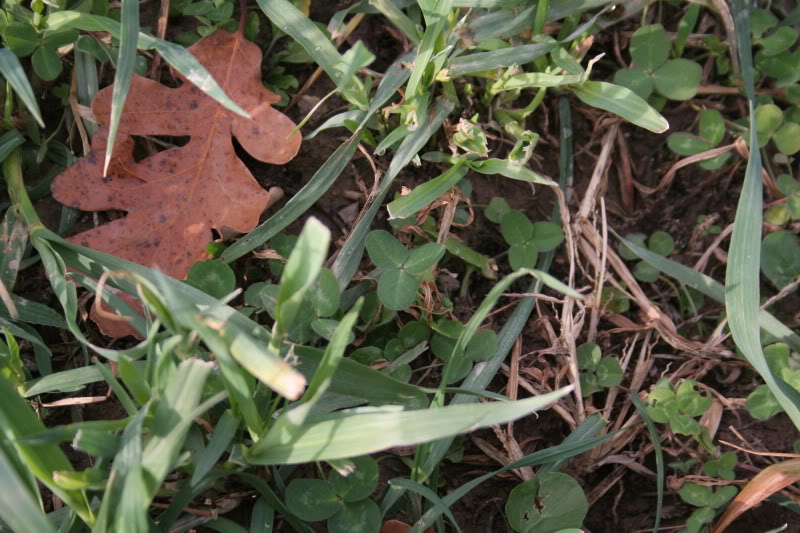
Here you can see every element of the mix and how they all are able to thrive together, each fulfilling a purpose to both feed deer and improve soils.
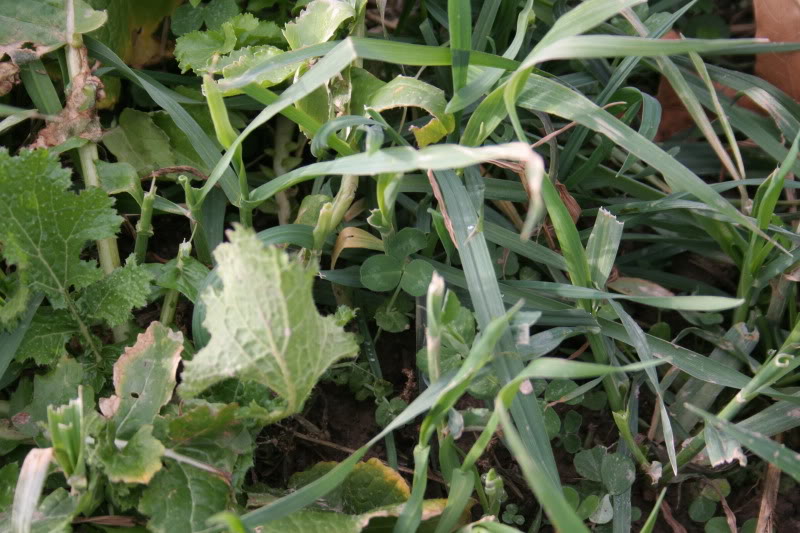
Even though well fertilized and obviously healthy and lush, whitetails have kept it grazed to 3-6" high
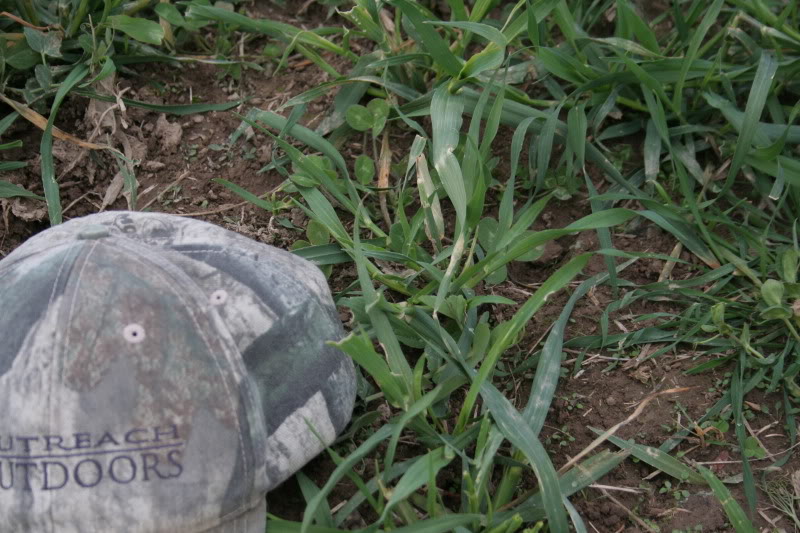
If they were not grazed they would be more then a foot high as we see here

The Groundhog forage radish is now being sought out with a vengeance!
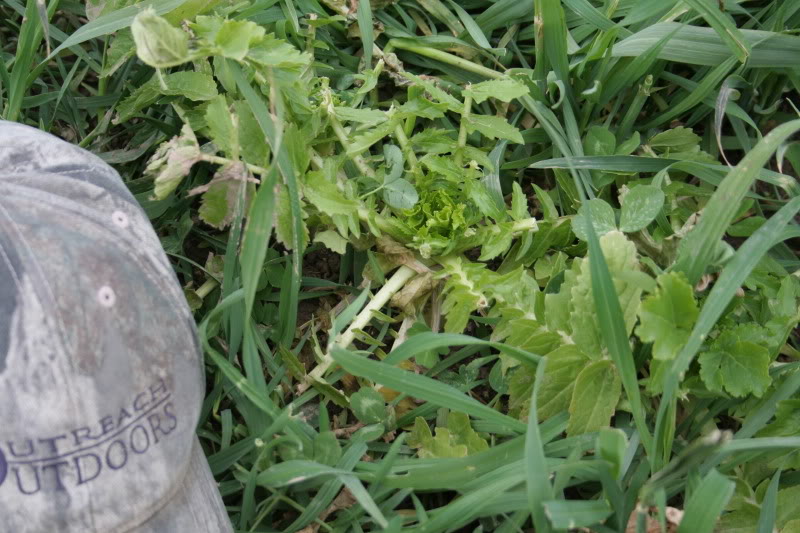
and not only tops but roots are now the target of hungry whitetails!

This mix you see, provides a near perfect balance or blend of crops that each grow and work in unison in every aspect. The rye and oats grow quickly and provide lush highly palatable grazing within weeks after planting. They can grow on almost any soils and climates and both highly sought after by deer.
Forage peas are a no brainer...deer candy and I doubt few people would argue this fact. The radish plants grow on the side lines at first because deer rarely focus on them until they are 30-45 days old which works perfectly because it allows them to grow and put down the roots they are famous for, roots that will be attractive later in the season and serve a valuable purpose in our efforts to build our soils.
Clovers...silently growing, almost unseen and all but forgotten this fall, yet next spring they will provide the most economical source of high quality protein available to us! As mentioned for some, soils will not allow planting white or red clovers and for those people there are other options but for the bulk of us from Georgia to Maine...they are the final piece of the puzzle in this part of the habitat pie.
Together...they keep whitetails beating a path to this plot year around, making them incredibly easy to pattern and...harvest...

NO CROP WILL BE SUCCESSFUL WITHOUT COVER
That point is all to often forgotten and the landowners are puzzled ad frustrated when they don't see the hoped for results from their food sources. Lack of deer sightings leads them to second guess their plantings and invariably leads them to try almost any seed they think will "cure the problem" when in fact the problem lies 100% in the fact they do not have enough cover or poor cover at best.
Every property should be 90 to 95% cover if at all possible, timber or NWSG or a combination of the two...sometimes difficult when ag crops make up the bulk of the farm. Those same crops then dilute the attraction to the food sources planted solely for deer and further frustrate the landowner. Every property has limitations, positives and negatives and cover is like any ag crop. it may not thrive on poor soils so we have to work with what we have to make it better and that friends is the point of my first comments in this thread. If your hoping to plant some magic crop that will suddenly draw herds of giant whitetails to your farm....you will end up sadly disappointed. Concentrate on the cover elements of your habitat puzzle as Job 1, first priority....the rest will be easy although challenging at times to keep them from running out of feed....
The following pictures are from one farm where we have one feeding area per 80 acres and out of 4 feeding areas, one is standing soybeans which like other posts I have shared, proves interesting. Any of these deer can easily walk a few hundred yards to the soybeans but...they are quite content to bed beside their food source and not expend any unnecessary energy traveling to another place, nor are they wiling to just move to the soybeans altogether...point being that good cover will hold the deer and they will in turn take advantage of almost any food source we plant for them...no "magic" required...
I LOVE rye!
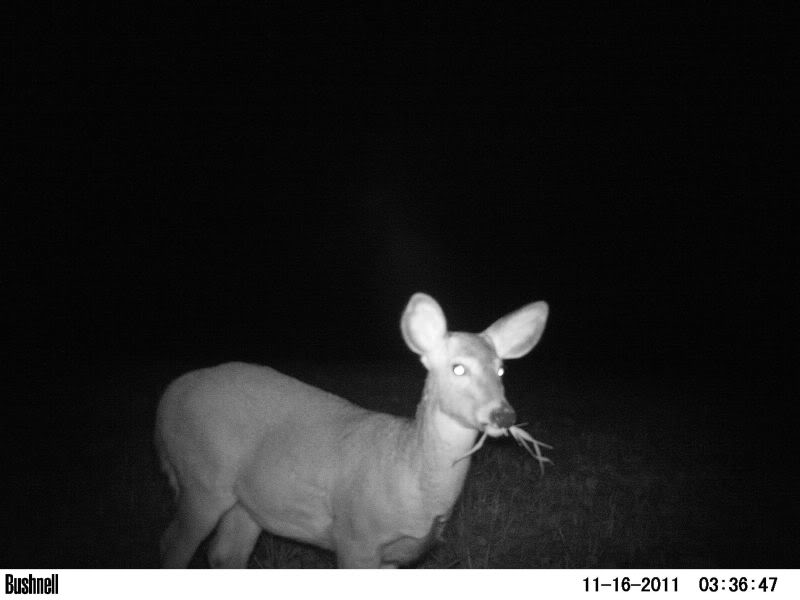
oh yeah...me too!
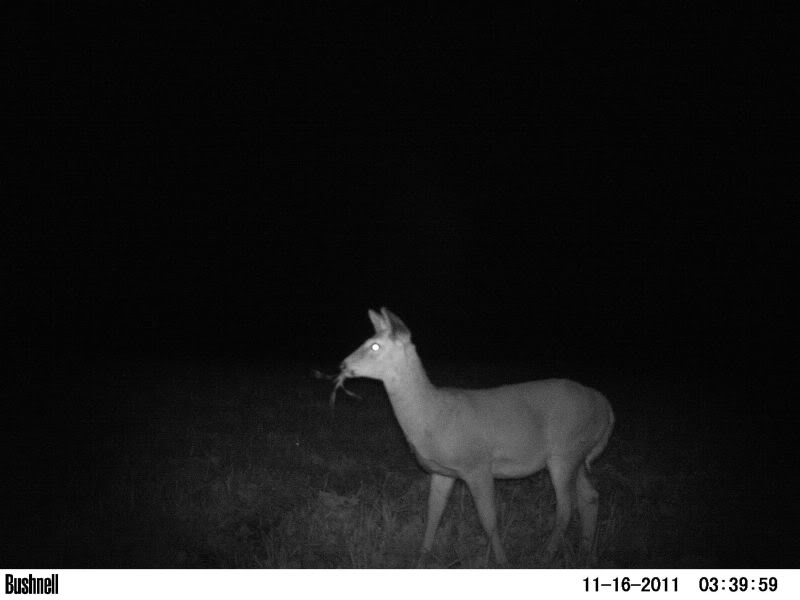
no nasty ole soybeans for me!
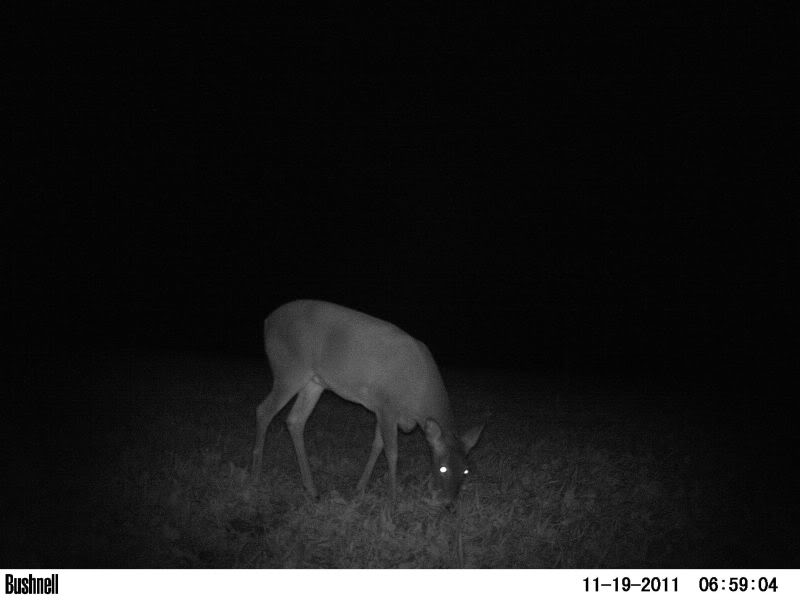
I hate wheat!
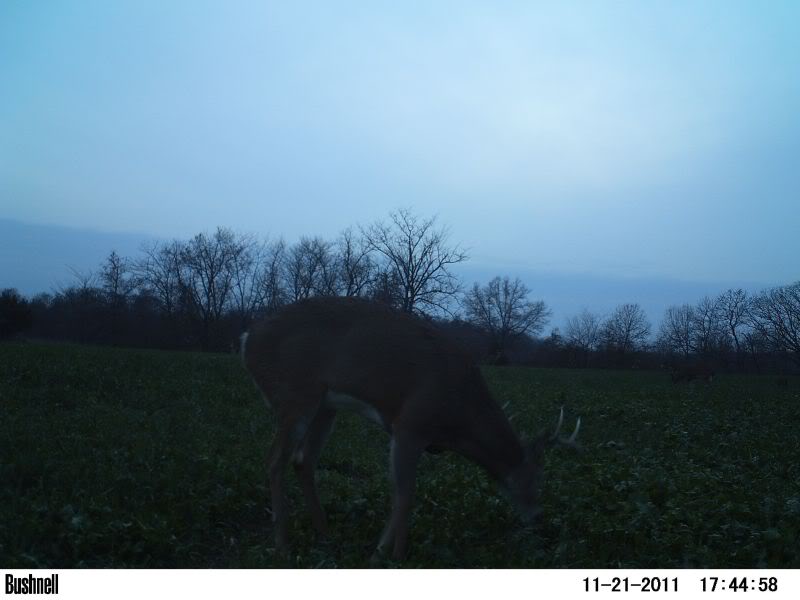
Hey...a little humor never hurts...but these deer have great cover, timber that has had TSI done and more radical hinging in process and that combined with open areas planted to NWSG that all equals GREAT COVER...and a mess of hungry deer!
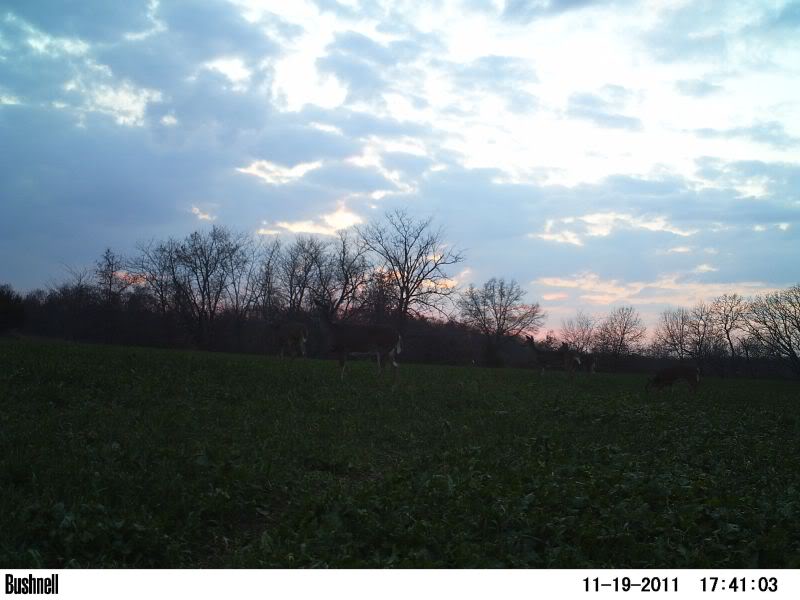
and that brings a lot of bucks that are not interested in eating...

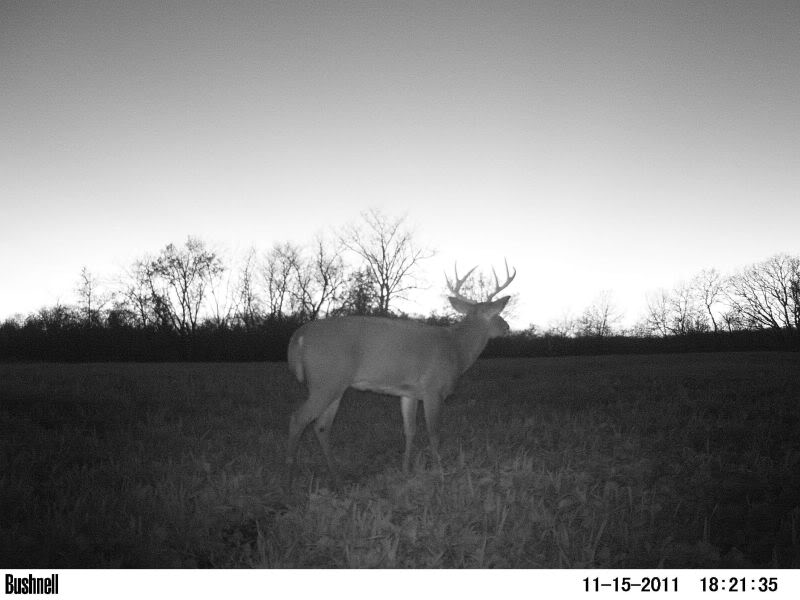
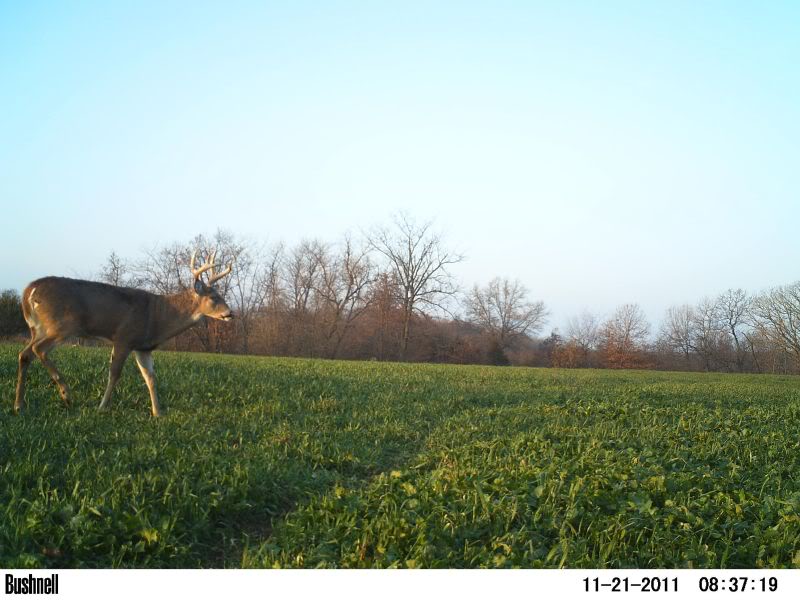

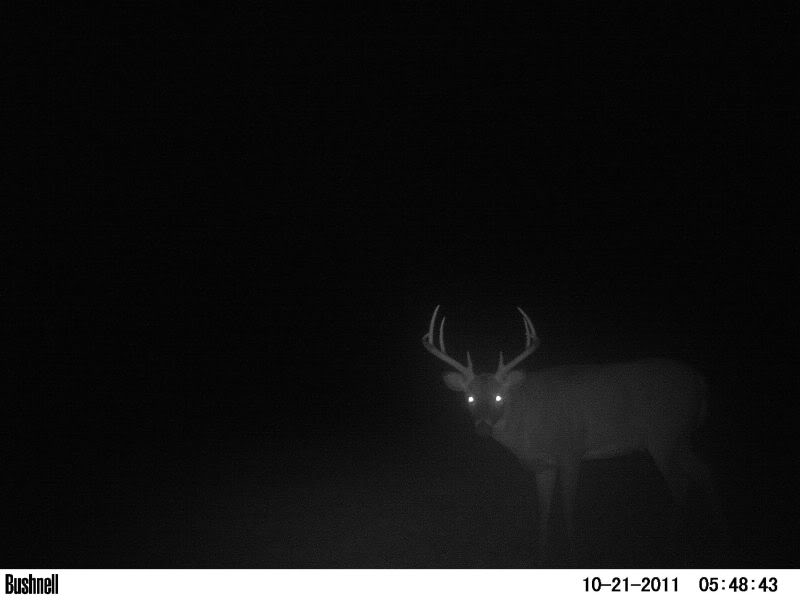
Each field of the above mentioned mix is full of deer

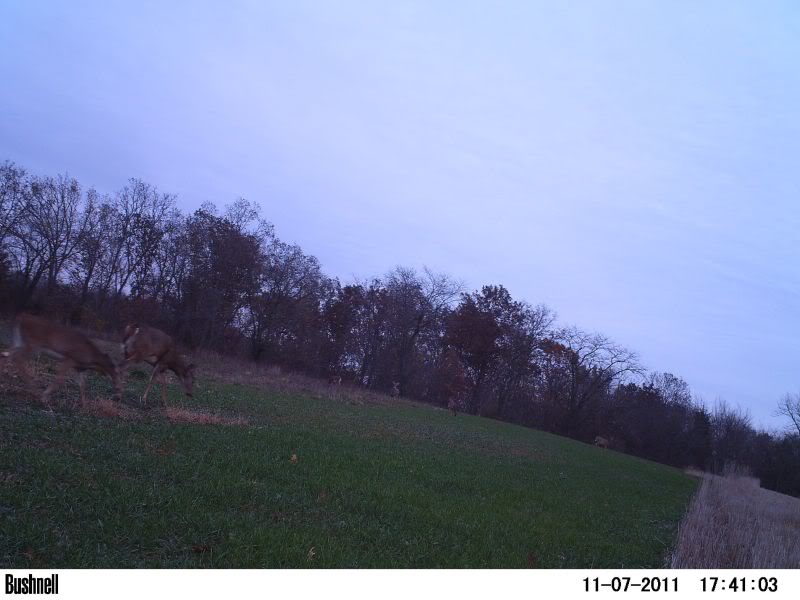
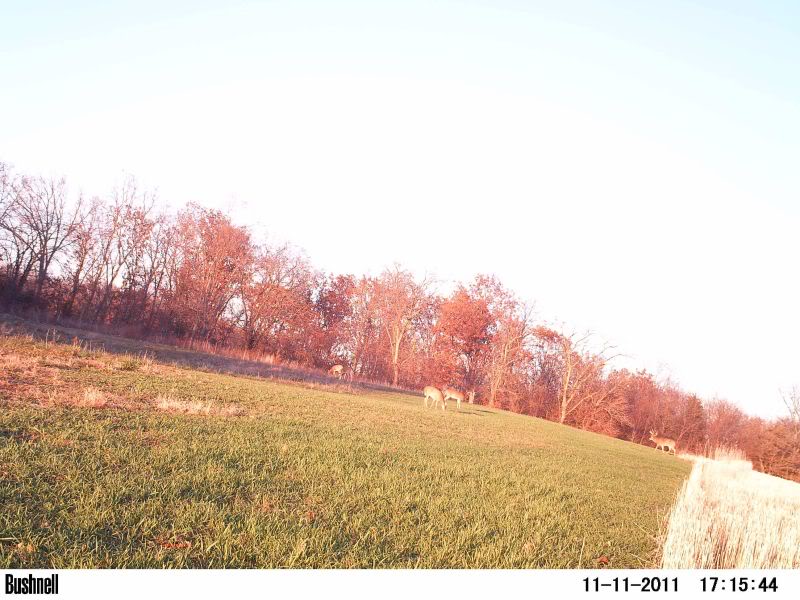
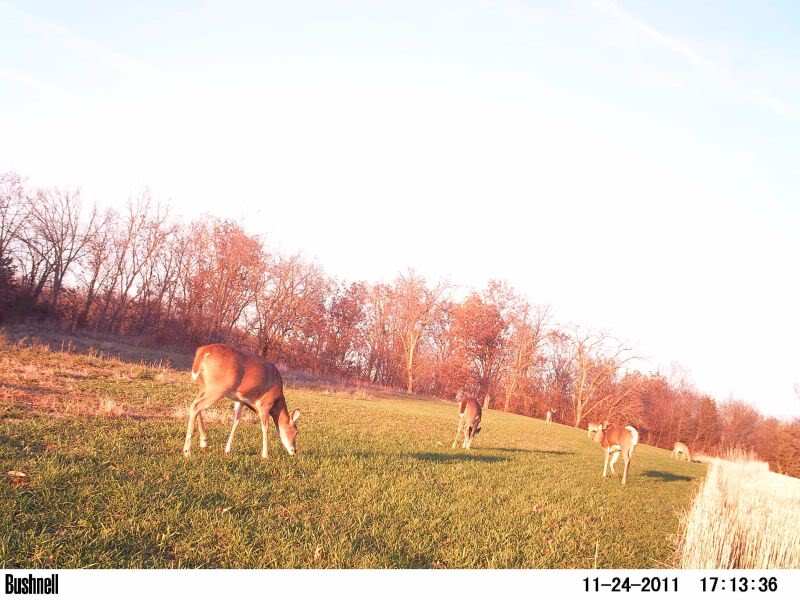
and bucks that could care less if the field is soybeans, wheat, rye or marshmallows for that matter

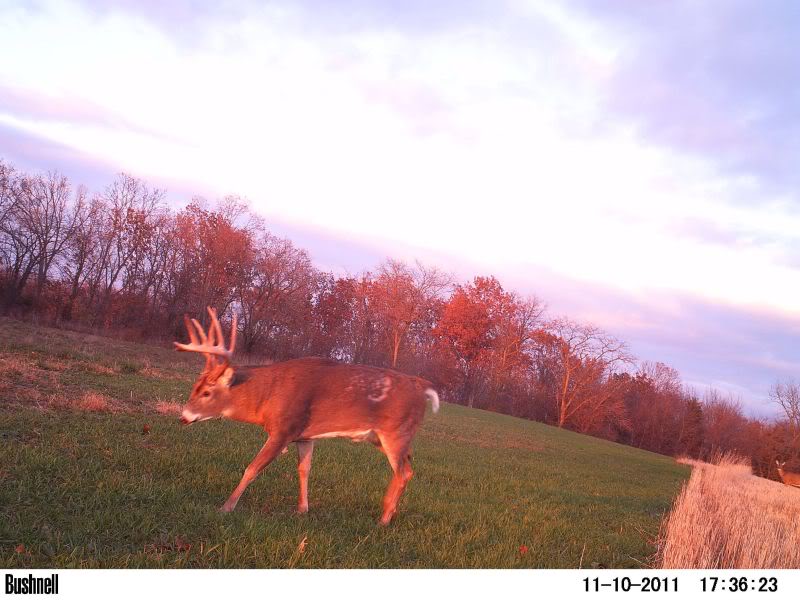
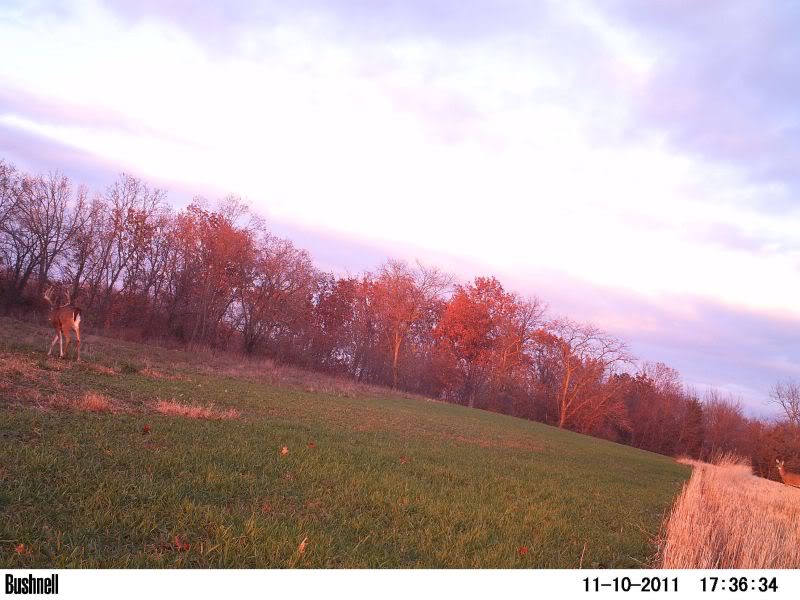
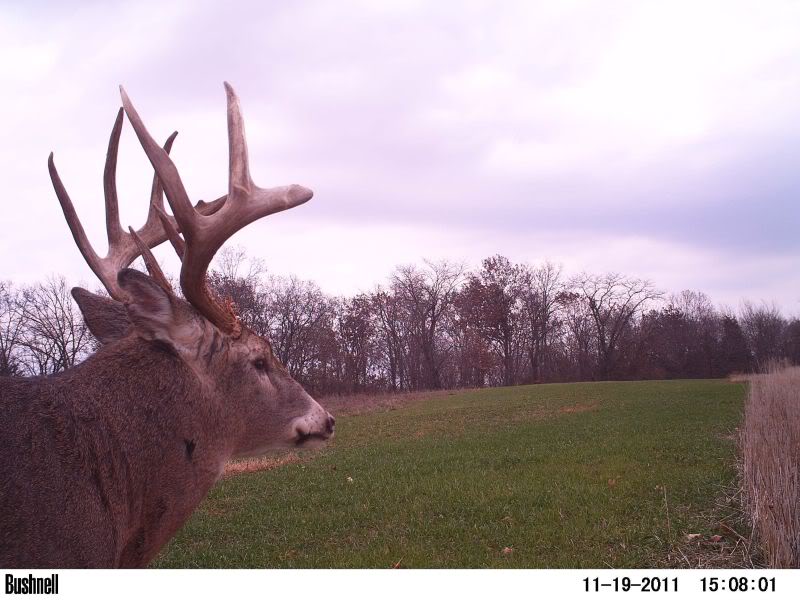
If you want a field full of deer and eventually mature bucks...forget about the silly arguments over which food source or seed people do their best to convince you is best...create premium cover and the rest will fall into place....easy as pie....
dbltree
Super Moderator
Paul,
In one of my plots the rye looks about 12" long.
Will it be to stemmy to attract them or will it depend on how hungry they get?
Yes there are other items in it and the GFR and PTT are not far away.
Maybe I will have to plant it a little later next year?
If they get hungry enough they will still eat it but in your case i think they have plenty of food sources with the adjacent ag crops that they just have more then they need.
Plant a little later and maybe you need less as well Tony...
dbltree
Super Moderator
It's always nice to get feedback from others who are willing to share the results of their plantings which then gives others the confidence to try something different as well. The following is a note from a friend on how his rye combination planting worked for him....
Every farm is unique and different with deer numbers that vary from a couple to a hundred per square mile so the results of any habitat improvement may vary widely. That being said the rye combination mix shared in this thread will by and large work very well for most landowners across the country.
More pics from another field of winter rye/oats/peas/radish and red clover where deer have the option of choosing standing soybeans and/or winter wheat and harvested stubble fields. They are gradually eating this field to nubs also....



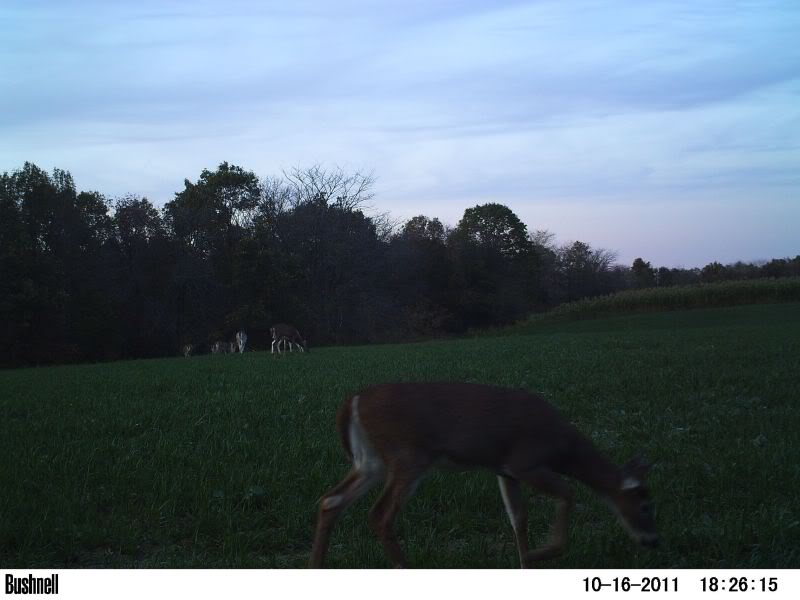
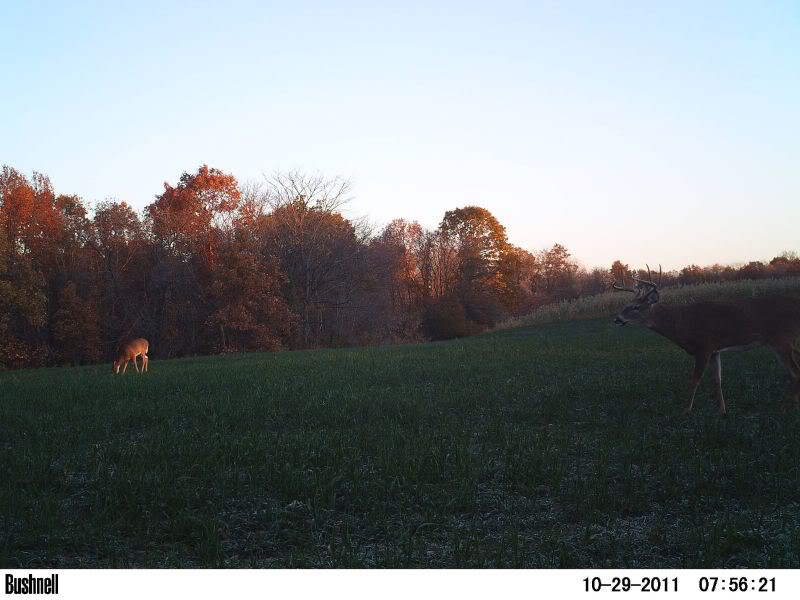
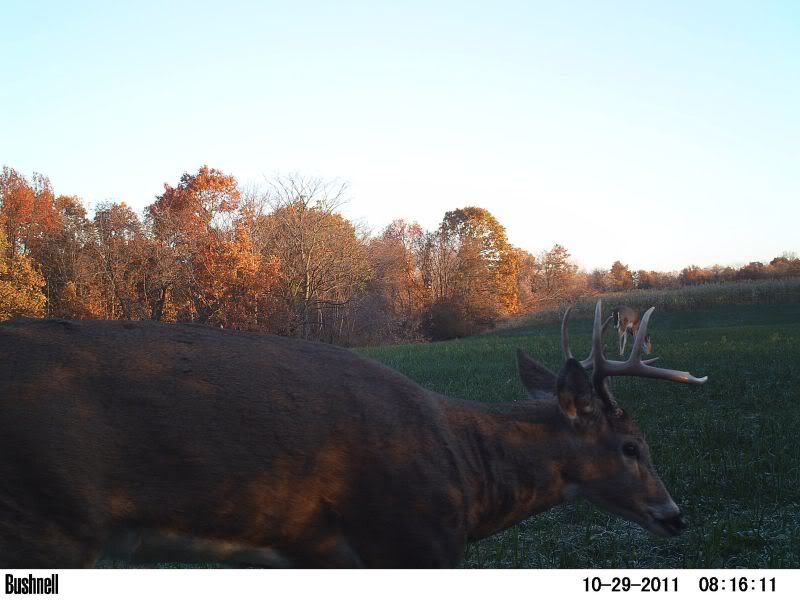

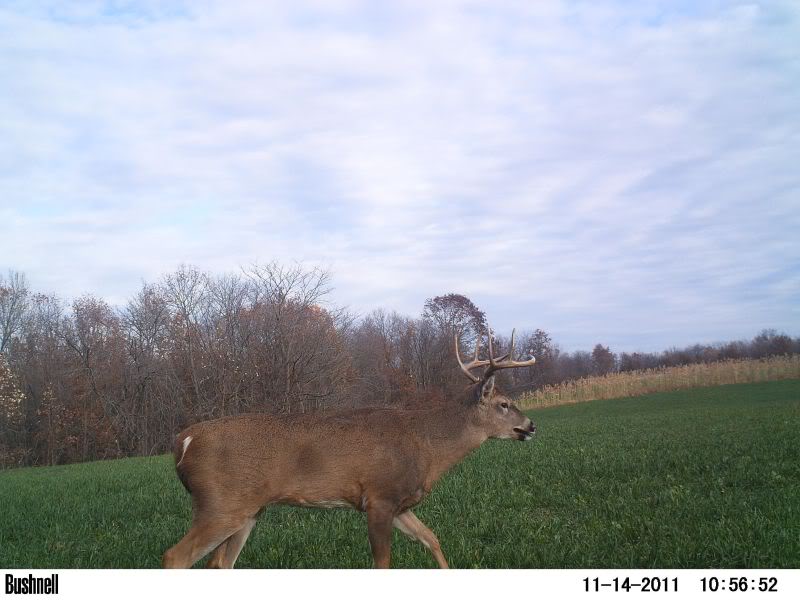
I have posted pics in other threads of 170+ class bucks searching this field for does during the rut and I expect when the weather gets cold and the snow starts flying...they'll be back to fill their bellies....
Paul,
I just wanted to tell you how well your rye combo is working on my farm. I have 58 acres of which about 30 is timber, ~ 3 acres plots, and the rest in riparian buffers or NWSG. This area has some timber but is definitely ag, with 100's of acres of corn and beans just over every fence.
I planted 1/2 acre corn, about 2 acres beans, and about 3/4 acre of your rye mix spread out on 4 small plots. Normal residential deer pop is only about 10-20 animals. Even with all this food around ALL of the rye plots are mowed to a nub! I have overseeded beans with rye before but this is the first time I have tried your actual mix and it is working amazingly well. I wouldn't have guessed it, but its like deer crack! Every single deer that comes to the plots will hit the rye mix. Every time! Cheap, easy, and best of all, it works in tiny little plots that I couldn't put beans or corn in.
Just wanted to thank you again for sharing all your knowledge on this site. My whole farm is basically shaped by your posts, and this stuff works, all of it. None of my neighbors do anything for habitat other than pheasant plots, and the deer absolutely pour into my place every year about this time. The only thing they aren't hitting yet is the straight brassica plot (what little didn't get hit by disease) but I bet that will change when the beans run out this winter.
Thanks again
Every farm is unique and different with deer numbers that vary from a couple to a hundred per square mile so the results of any habitat improvement may vary widely. That being said the rye combination mix shared in this thread will by and large work very well for most landowners across the country.
More pics from another field of winter rye/oats/peas/radish and red clover where deer have the option of choosing standing soybeans and/or winter wheat and harvested stubble fields. They are gradually eating this field to nubs also....








I have posted pics in other threads of 170+ class bucks searching this field for does during the rut and I expect when the weather gets cold and the snow starts flying...they'll be back to fill their bellies....
